Social Media Marketing and Traditional Marketing in Airlines Industry
VerifiedAdded on 2023/04/23
|33
|8031
|314
AI Summary
This dissertation explores the difference between social media marketing and traditional marketing in the airlines industry. It uses a deductive approach, descriptive design, and case study research strategy. The data collection process is secondary, and the data analysis technique is qualitative.
Contribute Materials
Your contribution can guide someone’s learning journey. Share your
documents today.
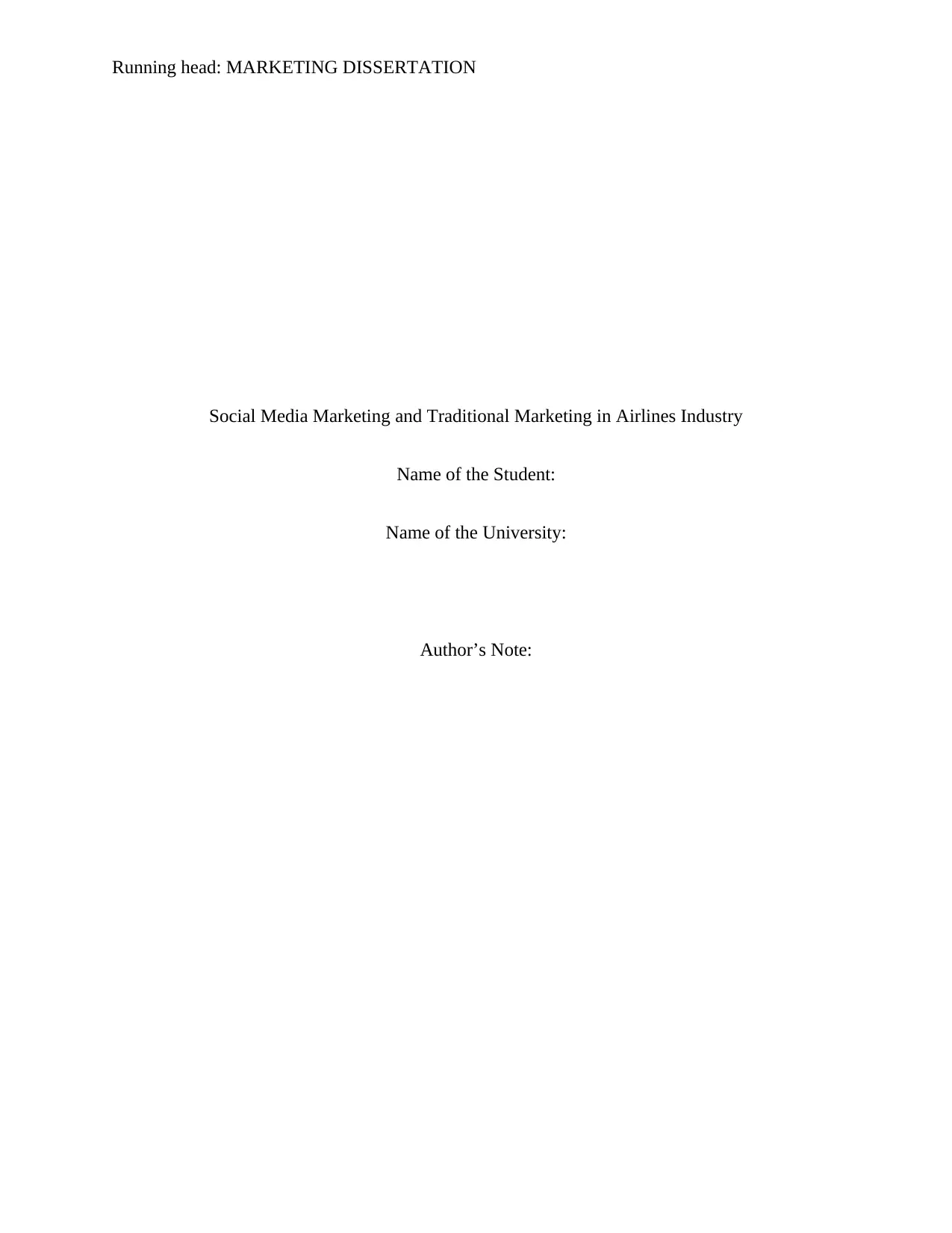
Running head: MARKETING DISSERTATION
Social Media Marketing and Traditional Marketing in Airlines Industry
Name of the Student:
Name of the University:
Author’s Note:
Social Media Marketing and Traditional Marketing in Airlines Industry
Name of the Student:
Name of the University:
Author’s Note:
Secure Best Marks with AI Grader
Need help grading? Try our AI Grader for instant feedback on your assignments.
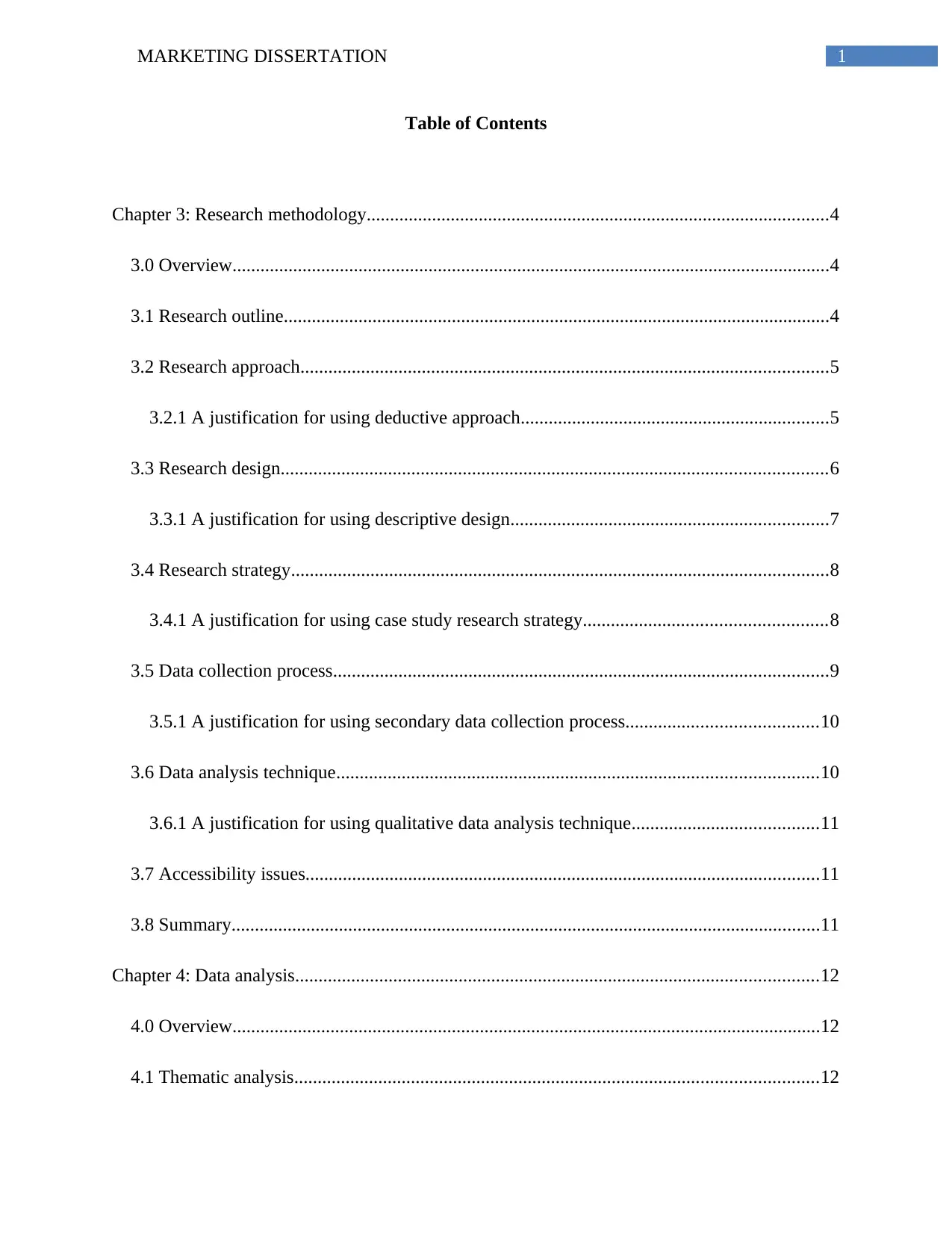
1MARKETING DISSERTATION
Table of Contents
Chapter 3: Research methodology...................................................................................................4
3.0 Overview................................................................................................................................4
3.1 Research outline.....................................................................................................................4
3.2 Research approach.................................................................................................................5
3.2.1 A justification for using deductive approach..................................................................5
3.3 Research design.....................................................................................................................6
3.3.1 A justification for using descriptive design....................................................................7
3.4 Research strategy...................................................................................................................8
3.4.1 A justification for using case study research strategy....................................................8
3.5 Data collection process..........................................................................................................9
3.5.1 A justification for using secondary data collection process.........................................10
3.6 Data analysis technique.......................................................................................................10
3.6.1 A justification for using qualitative data analysis technique........................................11
3.7 Accessibility issues..............................................................................................................11
3.8 Summary..............................................................................................................................11
Chapter 4: Data analysis................................................................................................................12
4.0 Overview..............................................................................................................................12
4.1 Thematic analysis................................................................................................................12
Table of Contents
Chapter 3: Research methodology...................................................................................................4
3.0 Overview................................................................................................................................4
3.1 Research outline.....................................................................................................................4
3.2 Research approach.................................................................................................................5
3.2.1 A justification for using deductive approach..................................................................5
3.3 Research design.....................................................................................................................6
3.3.1 A justification for using descriptive design....................................................................7
3.4 Research strategy...................................................................................................................8
3.4.1 A justification for using case study research strategy....................................................8
3.5 Data collection process..........................................................................................................9
3.5.1 A justification for using secondary data collection process.........................................10
3.6 Data analysis technique.......................................................................................................10
3.6.1 A justification for using qualitative data analysis technique........................................11
3.7 Accessibility issues..............................................................................................................11
3.8 Summary..............................................................................................................................11
Chapter 4: Data analysis................................................................................................................12
4.0 Overview..............................................................................................................................12
4.1 Thematic analysis................................................................................................................12
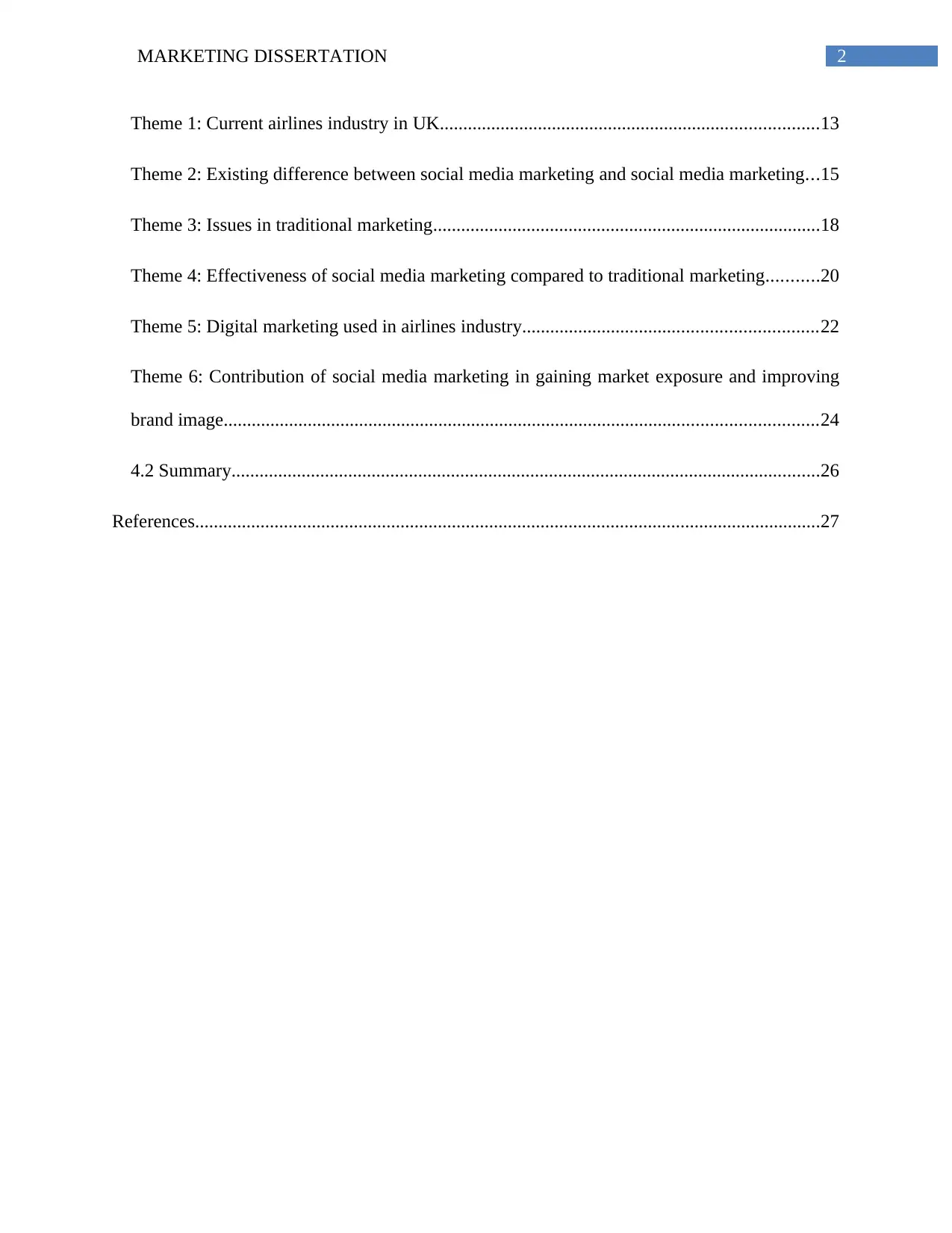
2MARKETING DISSERTATION
Theme 1: Current airlines industry in UK.................................................................................13
Theme 2: Existing difference between social media marketing and social media marketing...15
Theme 3: Issues in traditional marketing...................................................................................18
Theme 4: Effectiveness of social media marketing compared to traditional marketing...........20
Theme 5: Digital marketing used in airlines industry...............................................................22
Theme 6: Contribution of social media marketing in gaining market exposure and improving
brand image...............................................................................................................................24
4.2 Summary..............................................................................................................................26
References......................................................................................................................................27
Theme 1: Current airlines industry in UK.................................................................................13
Theme 2: Existing difference between social media marketing and social media marketing...15
Theme 3: Issues in traditional marketing...................................................................................18
Theme 4: Effectiveness of social media marketing compared to traditional marketing...........20
Theme 5: Digital marketing used in airlines industry...............................................................22
Theme 6: Contribution of social media marketing in gaining market exposure and improving
brand image...............................................................................................................................24
4.2 Summary..............................................................................................................................26
References......................................................................................................................................27
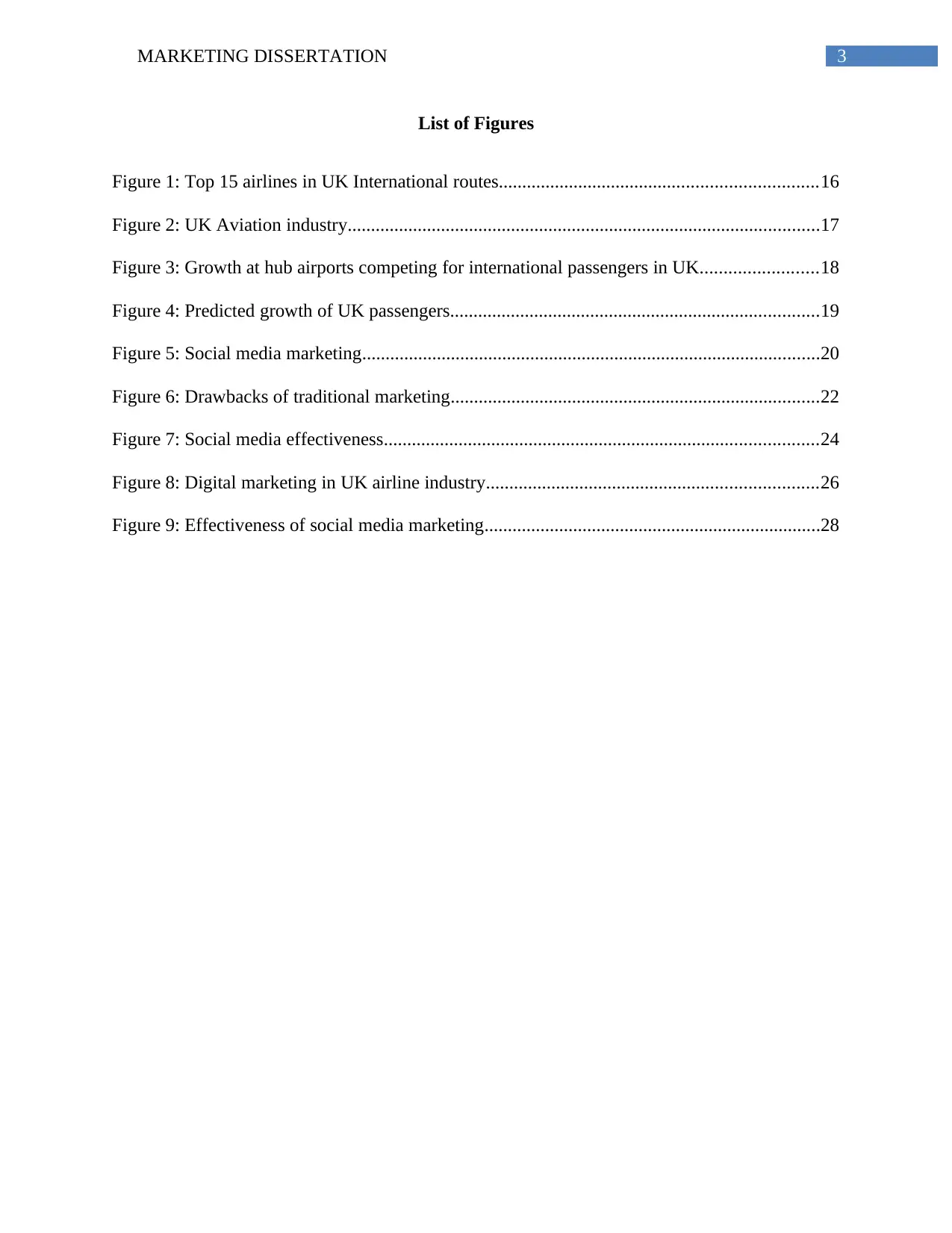
3MARKETING DISSERTATION
List of Figures
Figure 1: Top 15 airlines in UK International routes....................................................................16
Figure 2: UK Aviation industry.....................................................................................................17
Figure 3: Growth at hub airports competing for international passengers in UK.........................18
Figure 4: Predicted growth of UK passengers...............................................................................19
Figure 5: Social media marketing..................................................................................................20
Figure 6: Drawbacks of traditional marketing...............................................................................22
Figure 7: Social media effectiveness.............................................................................................24
Figure 8: Digital marketing in UK airline industry.......................................................................26
Figure 9: Effectiveness of social media marketing........................................................................28
List of Figures
Figure 1: Top 15 airlines in UK International routes....................................................................16
Figure 2: UK Aviation industry.....................................................................................................17
Figure 3: Growth at hub airports competing for international passengers in UK.........................18
Figure 4: Predicted growth of UK passengers...............................................................................19
Figure 5: Social media marketing..................................................................................................20
Figure 6: Drawbacks of traditional marketing...............................................................................22
Figure 7: Social media effectiveness.............................................................................................24
Figure 8: Digital marketing in UK airline industry.......................................................................26
Figure 9: Effectiveness of social media marketing........................................................................28
Secure Best Marks with AI Grader
Need help grading? Try our AI Grader for instant feedback on your assignments.
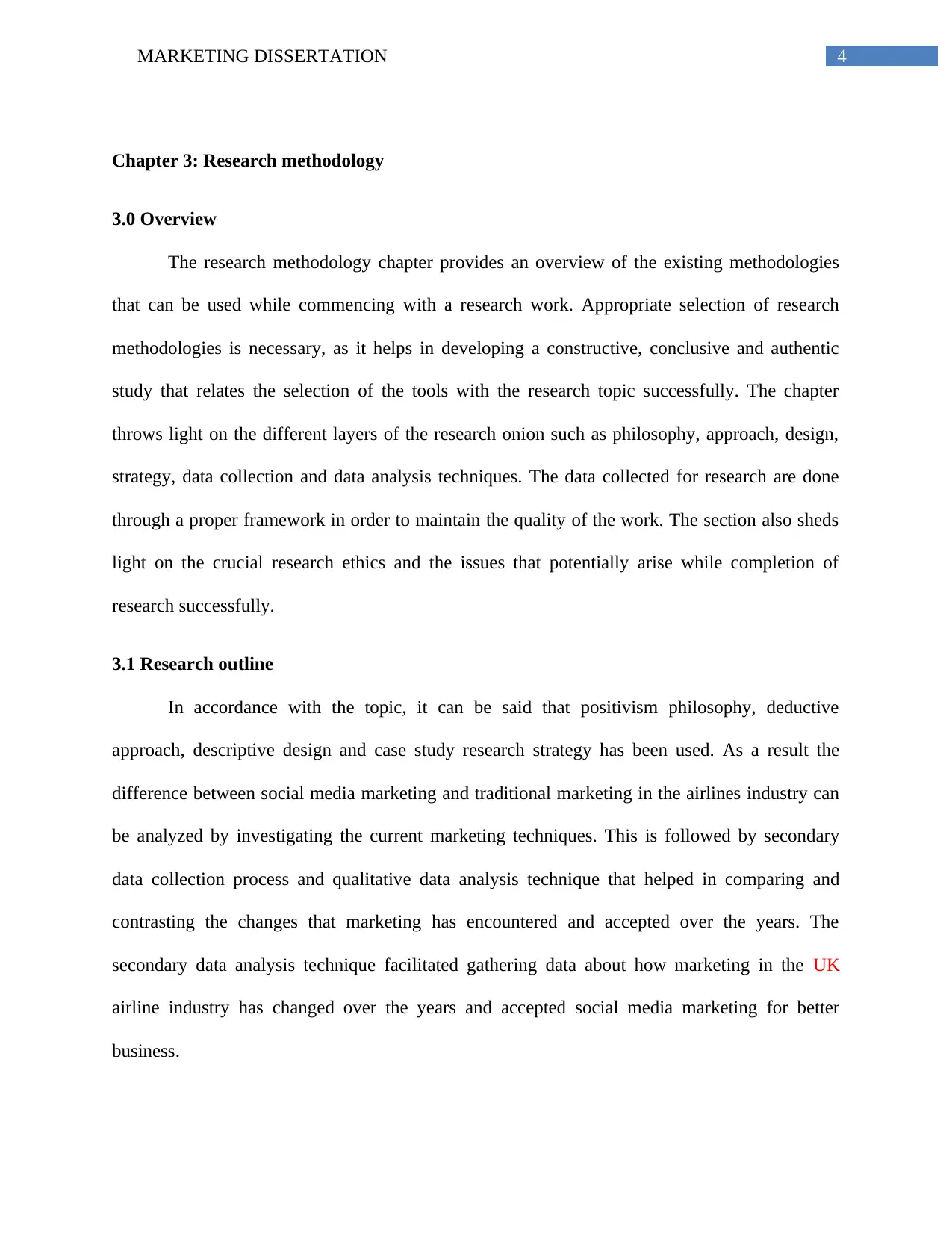
4MARKETING DISSERTATION
Chapter 3: Research methodology
3.0 Overview
The research methodology chapter provides an overview of the existing methodologies
that can be used while commencing with a research work. Appropriate selection of research
methodologies is necessary, as it helps in developing a constructive, conclusive and authentic
study that relates the selection of the tools with the research topic successfully. The chapter
throws light on the different layers of the research onion such as philosophy, approach, design,
strategy, data collection and data analysis techniques. The data collected for research are done
through a proper framework in order to maintain the quality of the work. The section also sheds
light on the crucial research ethics and the issues that potentially arise while completion of
research successfully.
3.1 Research outline
In accordance with the topic, it can be said that positivism philosophy, deductive
approach, descriptive design and case study research strategy has been used. As a result the
difference between social media marketing and traditional marketing in the airlines industry can
be analyzed by investigating the current marketing techniques. This is followed by secondary
data collection process and qualitative data analysis technique that helped in comparing and
contrasting the changes that marketing has encountered and accepted over the years. The
secondary data analysis technique facilitated gathering data about how marketing in the UK
airline industry has changed over the years and accepted social media marketing for better
business.
Chapter 3: Research methodology
3.0 Overview
The research methodology chapter provides an overview of the existing methodologies
that can be used while commencing with a research work. Appropriate selection of research
methodologies is necessary, as it helps in developing a constructive, conclusive and authentic
study that relates the selection of the tools with the research topic successfully. The chapter
throws light on the different layers of the research onion such as philosophy, approach, design,
strategy, data collection and data analysis techniques. The data collected for research are done
through a proper framework in order to maintain the quality of the work. The section also sheds
light on the crucial research ethics and the issues that potentially arise while completion of
research successfully.
3.1 Research outline
In accordance with the topic, it can be said that positivism philosophy, deductive
approach, descriptive design and case study research strategy has been used. As a result the
difference between social media marketing and traditional marketing in the airlines industry can
be analyzed by investigating the current marketing techniques. This is followed by secondary
data collection process and qualitative data analysis technique that helped in comparing and
contrasting the changes that marketing has encountered and accepted over the years. The
secondary data analysis technique facilitated gathering data about how marketing in the UK
airline industry has changed over the years and accepted social media marketing for better
business.
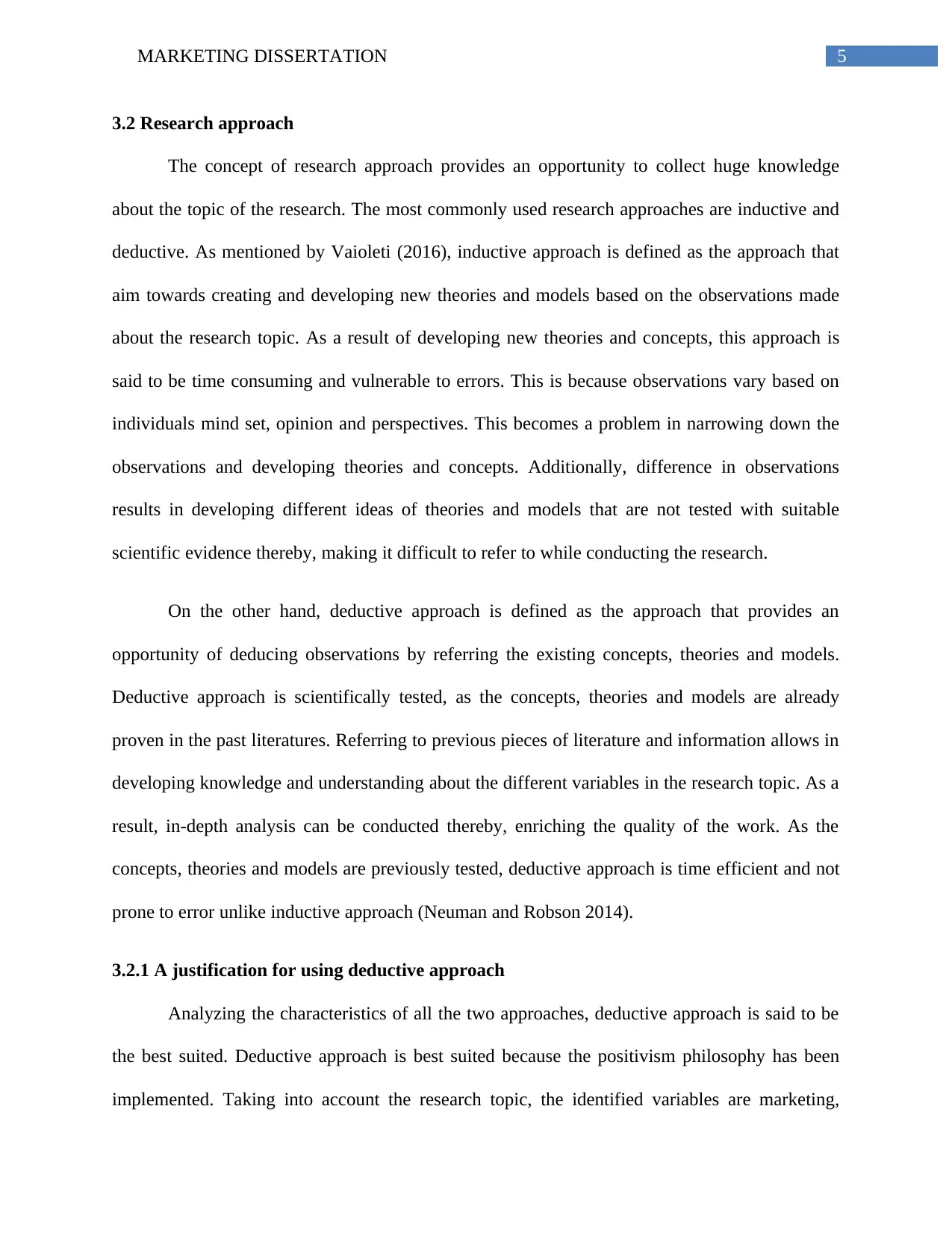
5MARKETING DISSERTATION
3.2 Research approach
The concept of research approach provides an opportunity to collect huge knowledge
about the topic of the research. The most commonly used research approaches are inductive and
deductive. As mentioned by Vaioleti (2016), inductive approach is defined as the approach that
aim towards creating and developing new theories and models based on the observations made
about the research topic. As a result of developing new theories and concepts, this approach is
said to be time consuming and vulnerable to errors. This is because observations vary based on
individuals mind set, opinion and perspectives. This becomes a problem in narrowing down the
observations and developing theories and concepts. Additionally, difference in observations
results in developing different ideas of theories and models that are not tested with suitable
scientific evidence thereby, making it difficult to refer to while conducting the research.
On the other hand, deductive approach is defined as the approach that provides an
opportunity of deducing observations by referring the existing concepts, theories and models.
Deductive approach is scientifically tested, as the concepts, theories and models are already
proven in the past literatures. Referring to previous pieces of literature and information allows in
developing knowledge and understanding about the different variables in the research topic. As a
result, in-depth analysis can be conducted thereby, enriching the quality of the work. As the
concepts, theories and models are previously tested, deductive approach is time efficient and not
prone to error unlike inductive approach (Neuman and Robson 2014).
3.2.1 A justification for using deductive approach
Analyzing the characteristics of all the two approaches, deductive approach is said to be
the best suited. Deductive approach is best suited because the positivism philosophy has been
implemented. Taking into account the research topic, the identified variables are marketing,
3.2 Research approach
The concept of research approach provides an opportunity to collect huge knowledge
about the topic of the research. The most commonly used research approaches are inductive and
deductive. As mentioned by Vaioleti (2016), inductive approach is defined as the approach that
aim towards creating and developing new theories and models based on the observations made
about the research topic. As a result of developing new theories and concepts, this approach is
said to be time consuming and vulnerable to errors. This is because observations vary based on
individuals mind set, opinion and perspectives. This becomes a problem in narrowing down the
observations and developing theories and concepts. Additionally, difference in observations
results in developing different ideas of theories and models that are not tested with suitable
scientific evidence thereby, making it difficult to refer to while conducting the research.
On the other hand, deductive approach is defined as the approach that provides an
opportunity of deducing observations by referring the existing concepts, theories and models.
Deductive approach is scientifically tested, as the concepts, theories and models are already
proven in the past literatures. Referring to previous pieces of literature and information allows in
developing knowledge and understanding about the different variables in the research topic. As a
result, in-depth analysis can be conducted thereby, enriching the quality of the work. As the
concepts, theories and models are previously tested, deductive approach is time efficient and not
prone to error unlike inductive approach (Neuman and Robson 2014).
3.2.1 A justification for using deductive approach
Analyzing the characteristics of all the two approaches, deductive approach is said to be
the best suited. Deductive approach is best suited because the positivism philosophy has been
implemented. Taking into account the research topic, the identified variables are marketing,
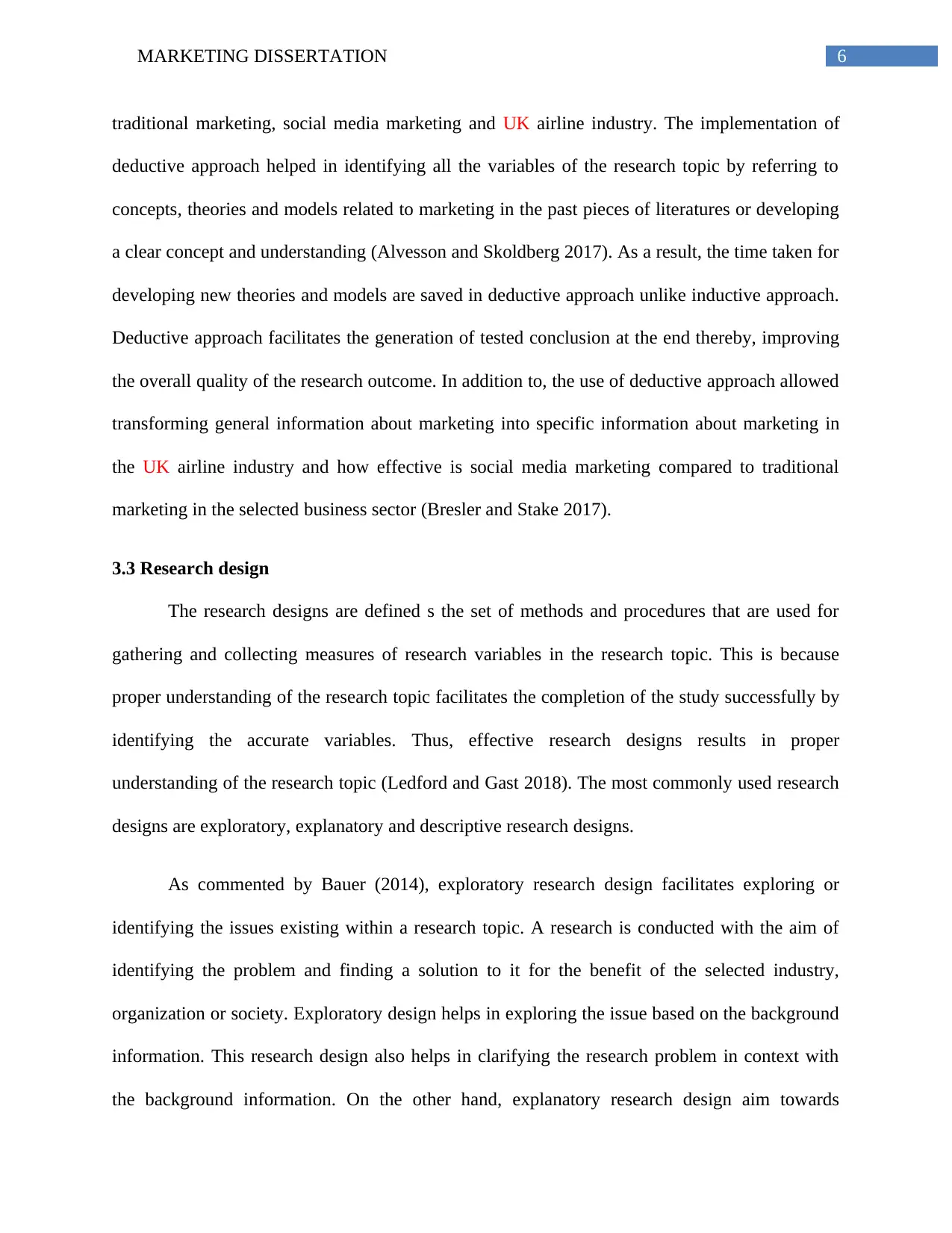
6MARKETING DISSERTATION
traditional marketing, social media marketing and UK airline industry. The implementation of
deductive approach helped in identifying all the variables of the research topic by referring to
concepts, theories and models related to marketing in the past pieces of literatures or developing
a clear concept and understanding (Alvesson and Skoldberg 2017). As a result, the time taken for
developing new theories and models are saved in deductive approach unlike inductive approach.
Deductive approach facilitates the generation of tested conclusion at the end thereby, improving
the overall quality of the research outcome. In addition to, the use of deductive approach allowed
transforming general information about marketing into specific information about marketing in
the UK airline industry and how effective is social media marketing compared to traditional
marketing in the selected business sector (Bresler and Stake 2017).
3.3 Research design
The research designs are defined s the set of methods and procedures that are used for
gathering and collecting measures of research variables in the research topic. This is because
proper understanding of the research topic facilitates the completion of the study successfully by
identifying the accurate variables. Thus, effective research designs results in proper
understanding of the research topic (Ledford and Gast 2018). The most commonly used research
designs are exploratory, explanatory and descriptive research designs.
As commented by Bauer (2014), exploratory research design facilitates exploring or
identifying the issues existing within a research topic. A research is conducted with the aim of
identifying the problem and finding a solution to it for the benefit of the selected industry,
organization or society. Exploratory design helps in exploring the issue based on the background
information. This research design also helps in clarifying the research problem in context with
the background information. On the other hand, explanatory research design aim towards
traditional marketing, social media marketing and UK airline industry. The implementation of
deductive approach helped in identifying all the variables of the research topic by referring to
concepts, theories and models related to marketing in the past pieces of literatures or developing
a clear concept and understanding (Alvesson and Skoldberg 2017). As a result, the time taken for
developing new theories and models are saved in deductive approach unlike inductive approach.
Deductive approach facilitates the generation of tested conclusion at the end thereby, improving
the overall quality of the research outcome. In addition to, the use of deductive approach allowed
transforming general information about marketing into specific information about marketing in
the UK airline industry and how effective is social media marketing compared to traditional
marketing in the selected business sector (Bresler and Stake 2017).
3.3 Research design
The research designs are defined s the set of methods and procedures that are used for
gathering and collecting measures of research variables in the research topic. This is because
proper understanding of the research topic facilitates the completion of the study successfully by
identifying the accurate variables. Thus, effective research designs results in proper
understanding of the research topic (Ledford and Gast 2018). The most commonly used research
designs are exploratory, explanatory and descriptive research designs.
As commented by Bauer (2014), exploratory research design facilitates exploring or
identifying the issues existing within a research topic. A research is conducted with the aim of
identifying the problem and finding a solution to it for the benefit of the selected industry,
organization or society. Exploratory design helps in exploring the issue based on the background
information. This research design also helps in clarifying the research problem in context with
the background information. On the other hand, explanatory research design aim towards
Paraphrase This Document
Need a fresh take? Get an instant paraphrase of this document with our AI Paraphraser
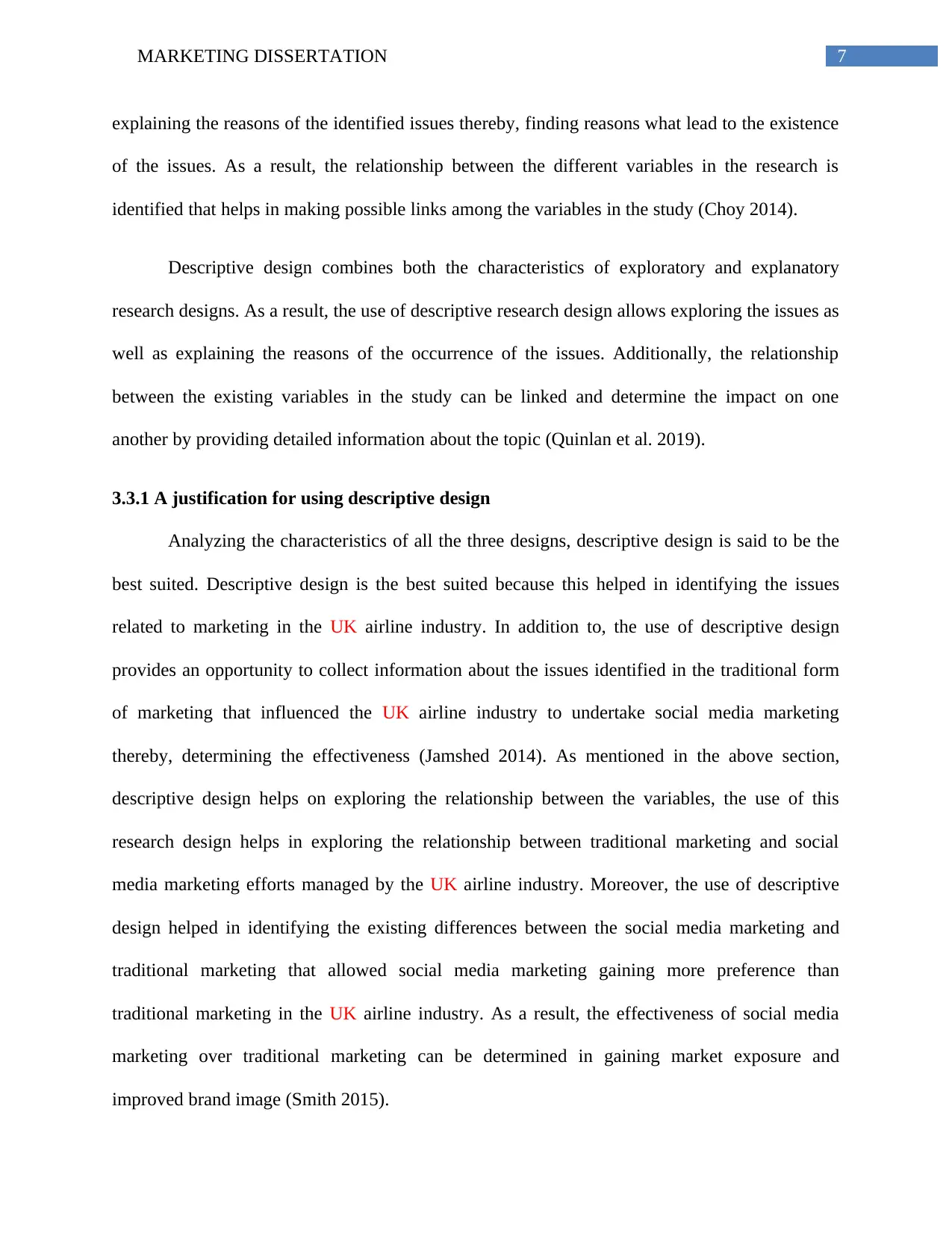
7MARKETING DISSERTATION
explaining the reasons of the identified issues thereby, finding reasons what lead to the existence
of the issues. As a result, the relationship between the different variables in the research is
identified that helps in making possible links among the variables in the study (Choy 2014).
Descriptive design combines both the characteristics of exploratory and explanatory
research designs. As a result, the use of descriptive research design allows exploring the issues as
well as explaining the reasons of the occurrence of the issues. Additionally, the relationship
between the existing variables in the study can be linked and determine the impact on one
another by providing detailed information about the topic (Quinlan et al. 2019).
3.3.1 A justification for using descriptive design
Analyzing the characteristics of all the three designs, descriptive design is said to be the
best suited. Descriptive design is the best suited because this helped in identifying the issues
related to marketing in the UK airline industry. In addition to, the use of descriptive design
provides an opportunity to collect information about the issues identified in the traditional form
of marketing that influenced the UK airline industry to undertake social media marketing
thereby, determining the effectiveness (Jamshed 2014). As mentioned in the above section,
descriptive design helps on exploring the relationship between the variables, the use of this
research design helps in exploring the relationship between traditional marketing and social
media marketing efforts managed by the UK airline industry. Moreover, the use of descriptive
design helped in identifying the existing differences between the social media marketing and
traditional marketing that allowed social media marketing gaining more preference than
traditional marketing in the UK airline industry. As a result, the effectiveness of social media
marketing over traditional marketing can be determined in gaining market exposure and
improved brand image (Smith 2015).
explaining the reasons of the identified issues thereby, finding reasons what lead to the existence
of the issues. As a result, the relationship between the different variables in the research is
identified that helps in making possible links among the variables in the study (Choy 2014).
Descriptive design combines both the characteristics of exploratory and explanatory
research designs. As a result, the use of descriptive research design allows exploring the issues as
well as explaining the reasons of the occurrence of the issues. Additionally, the relationship
between the existing variables in the study can be linked and determine the impact on one
another by providing detailed information about the topic (Quinlan et al. 2019).
3.3.1 A justification for using descriptive design
Analyzing the characteristics of all the three designs, descriptive design is said to be the
best suited. Descriptive design is the best suited because this helped in identifying the issues
related to marketing in the UK airline industry. In addition to, the use of descriptive design
provides an opportunity to collect information about the issues identified in the traditional form
of marketing that influenced the UK airline industry to undertake social media marketing
thereby, determining the effectiveness (Jamshed 2014). As mentioned in the above section,
descriptive design helps on exploring the relationship between the variables, the use of this
research design helps in exploring the relationship between traditional marketing and social
media marketing efforts managed by the UK airline industry. Moreover, the use of descriptive
design helped in identifying the existing differences between the social media marketing and
traditional marketing that allowed social media marketing gaining more preference than
traditional marketing in the UK airline industry. As a result, the effectiveness of social media
marketing over traditional marketing can be determined in gaining market exposure and
improved brand image (Smith 2015).
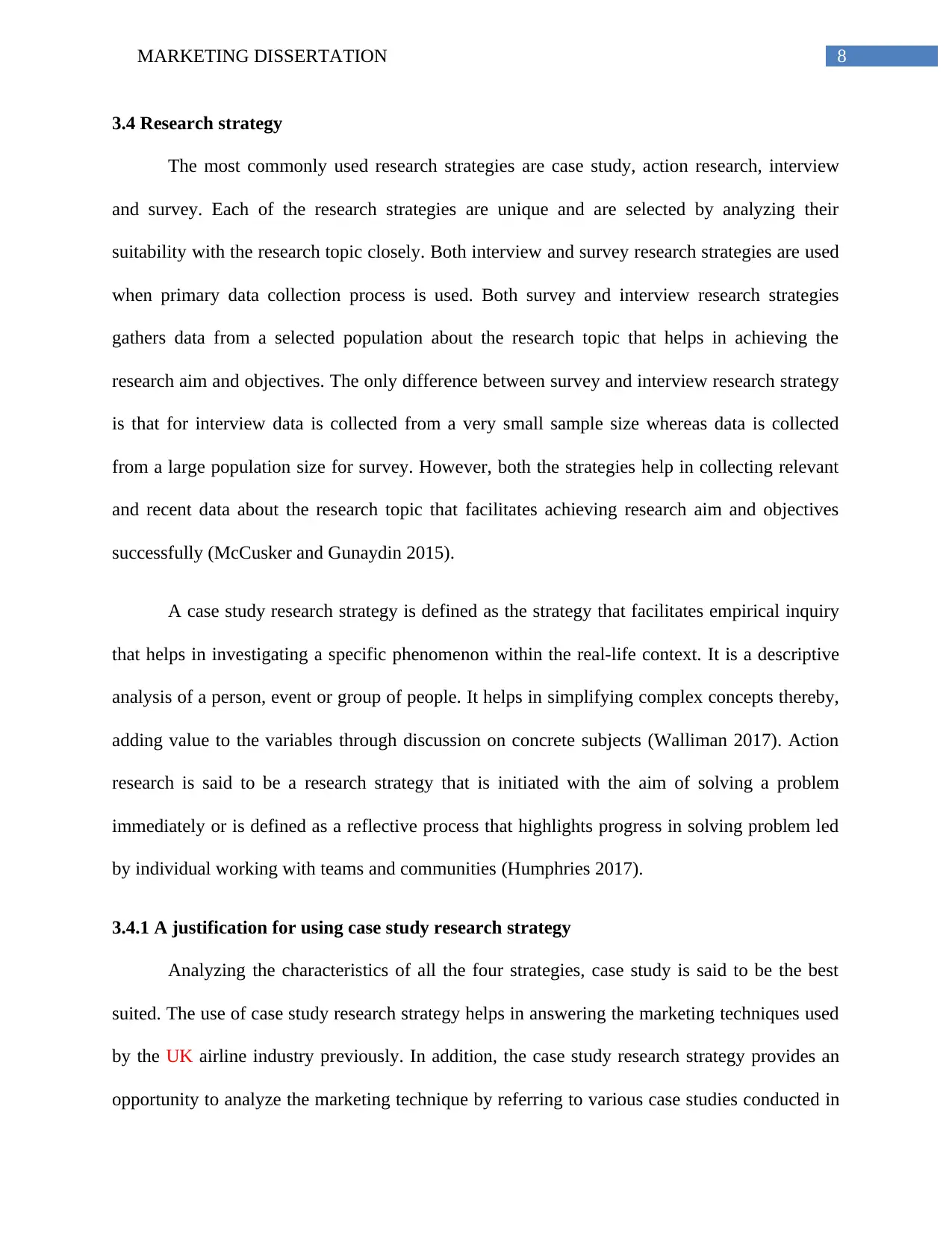
8MARKETING DISSERTATION
3.4 Research strategy
The most commonly used research strategies are case study, action research, interview
and survey. Each of the research strategies are unique and are selected by analyzing their
suitability with the research topic closely. Both interview and survey research strategies are used
when primary data collection process is used. Both survey and interview research strategies
gathers data from a selected population about the research topic that helps in achieving the
research aim and objectives. The only difference between survey and interview research strategy
is that for interview data is collected from a very small sample size whereas data is collected
from a large population size for survey. However, both the strategies help in collecting relevant
and recent data about the research topic that facilitates achieving research aim and objectives
successfully (McCusker and Gunaydin 2015).
A case study research strategy is defined as the strategy that facilitates empirical inquiry
that helps in investigating a specific phenomenon within the real-life context. It is a descriptive
analysis of a person, event or group of people. It helps in simplifying complex concepts thereby,
adding value to the variables through discussion on concrete subjects (Walliman 2017). Action
research is said to be a research strategy that is initiated with the aim of solving a problem
immediately or is defined as a reflective process that highlights progress in solving problem led
by individual working with teams and communities (Humphries 2017).
3.4.1 A justification for using case study research strategy
Analyzing the characteristics of all the four strategies, case study is said to be the best
suited. The use of case study research strategy helps in answering the marketing techniques used
by the UK airline industry previously. In addition, the case study research strategy provides an
opportunity to analyze the marketing technique by referring to various case studies conducted in
3.4 Research strategy
The most commonly used research strategies are case study, action research, interview
and survey. Each of the research strategies are unique and are selected by analyzing their
suitability with the research topic closely. Both interview and survey research strategies are used
when primary data collection process is used. Both survey and interview research strategies
gathers data from a selected population about the research topic that helps in achieving the
research aim and objectives. The only difference between survey and interview research strategy
is that for interview data is collected from a very small sample size whereas data is collected
from a large population size for survey. However, both the strategies help in collecting relevant
and recent data about the research topic that facilitates achieving research aim and objectives
successfully (McCusker and Gunaydin 2015).
A case study research strategy is defined as the strategy that facilitates empirical inquiry
that helps in investigating a specific phenomenon within the real-life context. It is a descriptive
analysis of a person, event or group of people. It helps in simplifying complex concepts thereby,
adding value to the variables through discussion on concrete subjects (Walliman 2017). Action
research is said to be a research strategy that is initiated with the aim of solving a problem
immediately or is defined as a reflective process that highlights progress in solving problem led
by individual working with teams and communities (Humphries 2017).
3.4.1 A justification for using case study research strategy
Analyzing the characteristics of all the four strategies, case study is said to be the best
suited. The use of case study research strategy helps in answering the marketing techniques used
by the UK airline industry previously. In addition, the case study research strategy provides an
opportunity to analyze the marketing technique by referring to various case studies conducted in
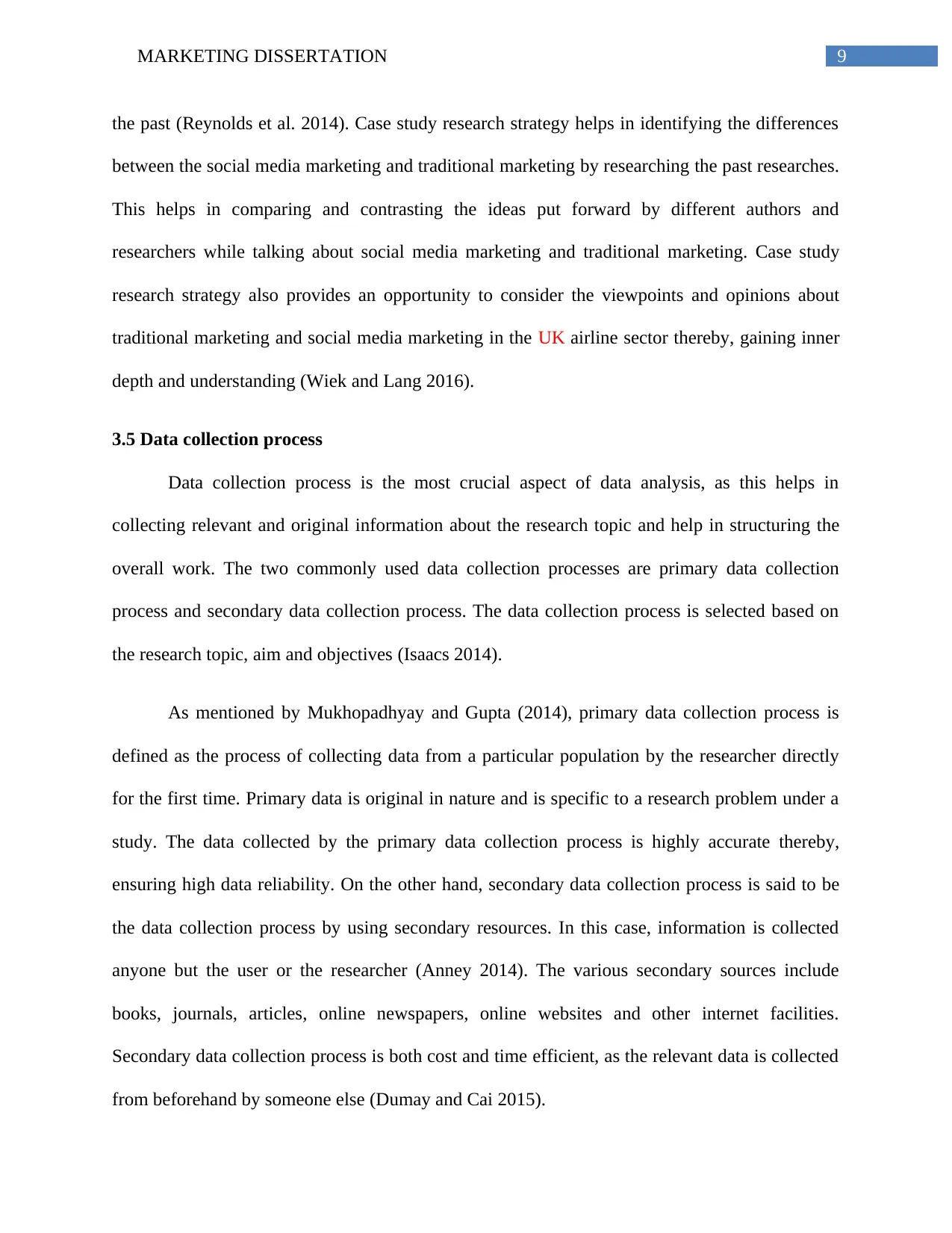
9MARKETING DISSERTATION
the past (Reynolds et al. 2014). Case study research strategy helps in identifying the differences
between the social media marketing and traditional marketing by researching the past researches.
This helps in comparing and contrasting the ideas put forward by different authors and
researchers while talking about social media marketing and traditional marketing. Case study
research strategy also provides an opportunity to consider the viewpoints and opinions about
traditional marketing and social media marketing in the UK airline sector thereby, gaining inner
depth and understanding (Wiek and Lang 2016).
3.5 Data collection process
Data collection process is the most crucial aspect of data analysis, as this helps in
collecting relevant and original information about the research topic and help in structuring the
overall work. The two commonly used data collection processes are primary data collection
process and secondary data collection process. The data collection process is selected based on
the research topic, aim and objectives (Isaacs 2014).
As mentioned by Mukhopadhyay and Gupta (2014), primary data collection process is
defined as the process of collecting data from a particular population by the researcher directly
for the first time. Primary data is original in nature and is specific to a research problem under a
study. The data collected by the primary data collection process is highly accurate thereby,
ensuring high data reliability. On the other hand, secondary data collection process is said to be
the data collection process by using secondary resources. In this case, information is collected
anyone but the user or the researcher (Anney 2014). The various secondary sources include
books, journals, articles, online newspapers, online websites and other internet facilities.
Secondary data collection process is both cost and time efficient, as the relevant data is collected
from beforehand by someone else (Dumay and Cai 2015).
the past (Reynolds et al. 2014). Case study research strategy helps in identifying the differences
between the social media marketing and traditional marketing by researching the past researches.
This helps in comparing and contrasting the ideas put forward by different authors and
researchers while talking about social media marketing and traditional marketing. Case study
research strategy also provides an opportunity to consider the viewpoints and opinions about
traditional marketing and social media marketing in the UK airline sector thereby, gaining inner
depth and understanding (Wiek and Lang 2016).
3.5 Data collection process
Data collection process is the most crucial aspect of data analysis, as this helps in
collecting relevant and original information about the research topic and help in structuring the
overall work. The two commonly used data collection processes are primary data collection
process and secondary data collection process. The data collection process is selected based on
the research topic, aim and objectives (Isaacs 2014).
As mentioned by Mukhopadhyay and Gupta (2014), primary data collection process is
defined as the process of collecting data from a particular population by the researcher directly
for the first time. Primary data is original in nature and is specific to a research problem under a
study. The data collected by the primary data collection process is highly accurate thereby,
ensuring high data reliability. On the other hand, secondary data collection process is said to be
the data collection process by using secondary resources. In this case, information is collected
anyone but the user or the researcher (Anney 2014). The various secondary sources include
books, journals, articles, online newspapers, online websites and other internet facilities.
Secondary data collection process is both cost and time efficient, as the relevant data is collected
from beforehand by someone else (Dumay and Cai 2015).
Secure Best Marks with AI Grader
Need help grading? Try our AI Grader for instant feedback on your assignments.
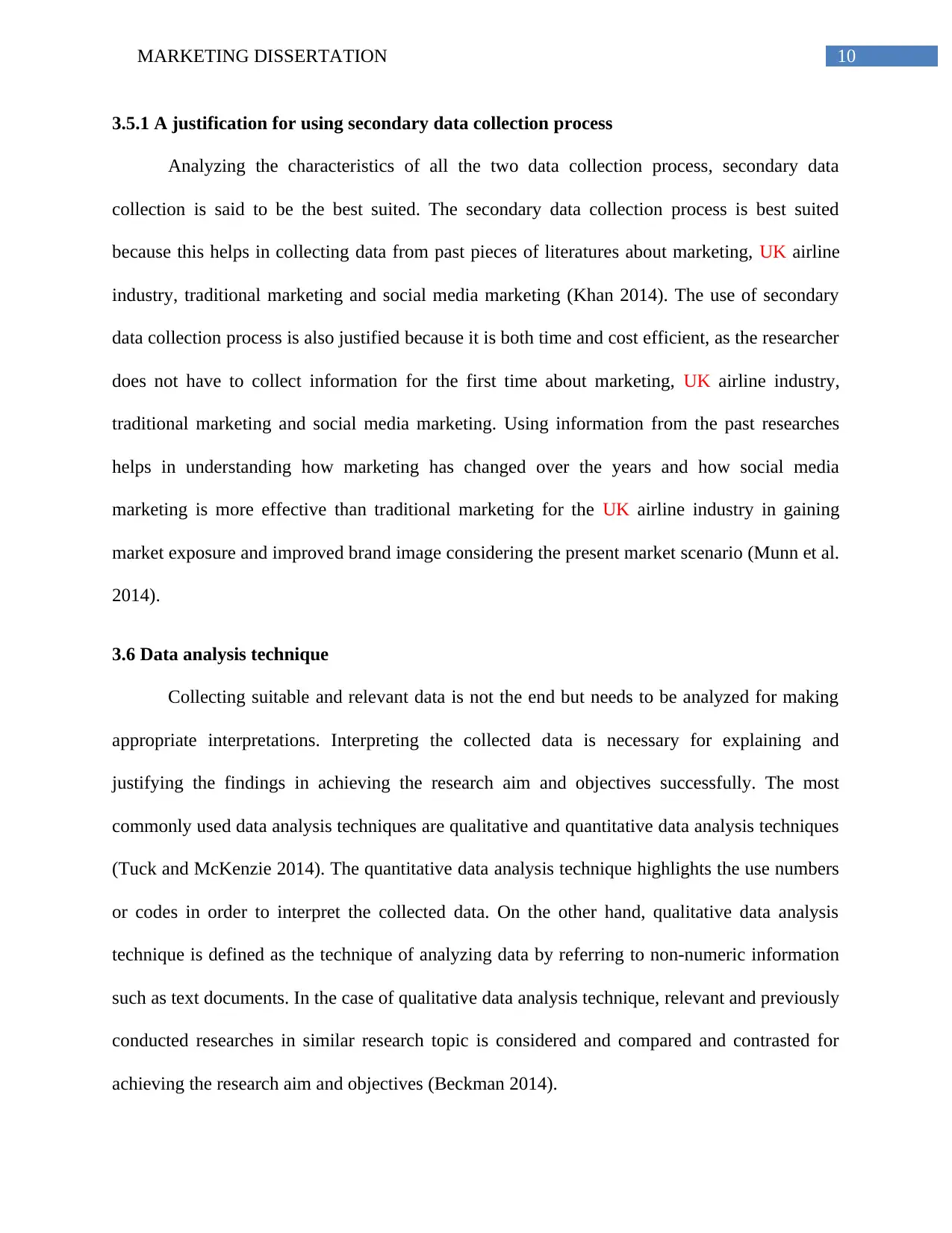
10MARKETING DISSERTATION
3.5.1 A justification for using secondary data collection process
Analyzing the characteristics of all the two data collection process, secondary data
collection is said to be the best suited. The secondary data collection process is best suited
because this helps in collecting data from past pieces of literatures about marketing, UK airline
industry, traditional marketing and social media marketing (Khan 2014). The use of secondary
data collection process is also justified because it is both time and cost efficient, as the researcher
does not have to collect information for the first time about marketing, UK airline industry,
traditional marketing and social media marketing. Using information from the past researches
helps in understanding how marketing has changed over the years and how social media
marketing is more effective than traditional marketing for the UK airline industry in gaining
market exposure and improved brand image considering the present market scenario (Munn et al.
2014).
3.6 Data analysis technique
Collecting suitable and relevant data is not the end but needs to be analyzed for making
appropriate interpretations. Interpreting the collected data is necessary for explaining and
justifying the findings in achieving the research aim and objectives successfully. The most
commonly used data analysis techniques are qualitative and quantitative data analysis techniques
(Tuck and McKenzie 2014). The quantitative data analysis technique highlights the use numbers
or codes in order to interpret the collected data. On the other hand, qualitative data analysis
technique is defined as the technique of analyzing data by referring to non-numeric information
such as text documents. In the case of qualitative data analysis technique, relevant and previously
conducted researches in similar research topic is considered and compared and contrasted for
achieving the research aim and objectives (Beckman 2014).
3.5.1 A justification for using secondary data collection process
Analyzing the characteristics of all the two data collection process, secondary data
collection is said to be the best suited. The secondary data collection process is best suited
because this helps in collecting data from past pieces of literatures about marketing, UK airline
industry, traditional marketing and social media marketing (Khan 2014). The use of secondary
data collection process is also justified because it is both time and cost efficient, as the researcher
does not have to collect information for the first time about marketing, UK airline industry,
traditional marketing and social media marketing. Using information from the past researches
helps in understanding how marketing has changed over the years and how social media
marketing is more effective than traditional marketing for the UK airline industry in gaining
market exposure and improved brand image considering the present market scenario (Munn et al.
2014).
3.6 Data analysis technique
Collecting suitable and relevant data is not the end but needs to be analyzed for making
appropriate interpretations. Interpreting the collected data is necessary for explaining and
justifying the findings in achieving the research aim and objectives successfully. The most
commonly used data analysis techniques are qualitative and quantitative data analysis techniques
(Tuck and McKenzie 2014). The quantitative data analysis technique highlights the use numbers
or codes in order to interpret the collected data. On the other hand, qualitative data analysis
technique is defined as the technique of analyzing data by referring to non-numeric information
such as text documents. In the case of qualitative data analysis technique, relevant and previously
conducted researches in similar research topic is considered and compared and contrasted for
achieving the research aim and objectives (Beckman 2014).
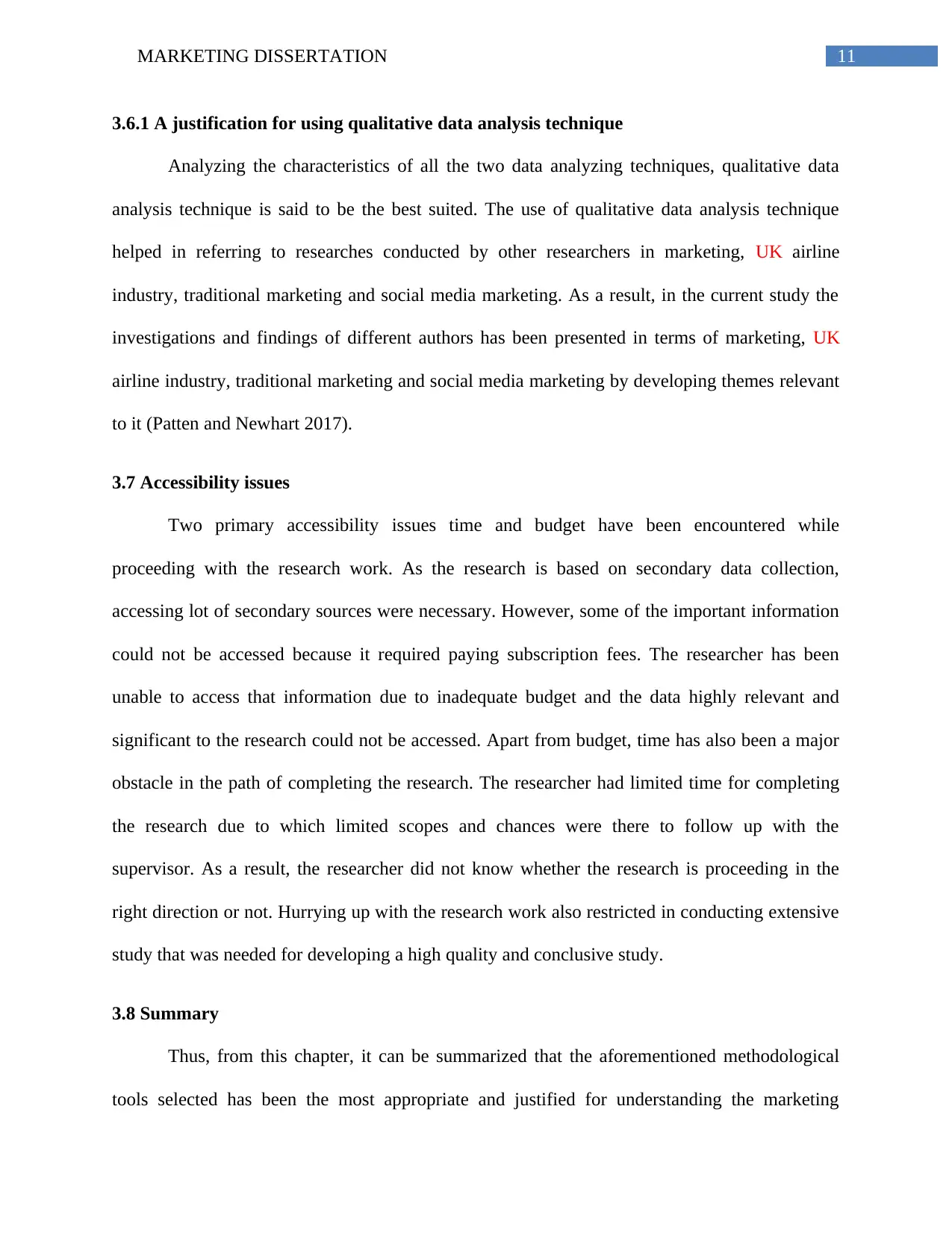
11MARKETING DISSERTATION
3.6.1 A justification for using qualitative data analysis technique
Analyzing the characteristics of all the two data analyzing techniques, qualitative data
analysis technique is said to be the best suited. The use of qualitative data analysis technique
helped in referring to researches conducted by other researchers in marketing, UK airline
industry, traditional marketing and social media marketing. As a result, in the current study the
investigations and findings of different authors has been presented in terms of marketing, UK
airline industry, traditional marketing and social media marketing by developing themes relevant
to it (Patten and Newhart 2017).
3.7 Accessibility issues
Two primary accessibility issues time and budget have been encountered while
proceeding with the research work. As the research is based on secondary data collection,
accessing lot of secondary sources were necessary. However, some of the important information
could not be accessed because it required paying subscription fees. The researcher has been
unable to access that information due to inadequate budget and the data highly relevant and
significant to the research could not be accessed. Apart from budget, time has also been a major
obstacle in the path of completing the research. The researcher had limited time for completing
the research due to which limited scopes and chances were there to follow up with the
supervisor. As a result, the researcher did not know whether the research is proceeding in the
right direction or not. Hurrying up with the research work also restricted in conducting extensive
study that was needed for developing a high quality and conclusive study.
3.8 Summary
Thus, from this chapter, it can be summarized that the aforementioned methodological
tools selected has been the most appropriate and justified for understanding the marketing
3.6.1 A justification for using qualitative data analysis technique
Analyzing the characteristics of all the two data analyzing techniques, qualitative data
analysis technique is said to be the best suited. The use of qualitative data analysis technique
helped in referring to researches conducted by other researchers in marketing, UK airline
industry, traditional marketing and social media marketing. As a result, in the current study the
investigations and findings of different authors has been presented in terms of marketing, UK
airline industry, traditional marketing and social media marketing by developing themes relevant
to it (Patten and Newhart 2017).
3.7 Accessibility issues
Two primary accessibility issues time and budget have been encountered while
proceeding with the research work. As the research is based on secondary data collection,
accessing lot of secondary sources were necessary. However, some of the important information
could not be accessed because it required paying subscription fees. The researcher has been
unable to access that information due to inadequate budget and the data highly relevant and
significant to the research could not be accessed. Apart from budget, time has also been a major
obstacle in the path of completing the research. The researcher had limited time for completing
the research due to which limited scopes and chances were there to follow up with the
supervisor. As a result, the researcher did not know whether the research is proceeding in the
right direction or not. Hurrying up with the research work also restricted in conducting extensive
study that was needed for developing a high quality and conclusive study.
3.8 Summary
Thus, from this chapter, it can be summarized that the aforementioned methodological
tools selected has been the most appropriate and justified for understanding the marketing
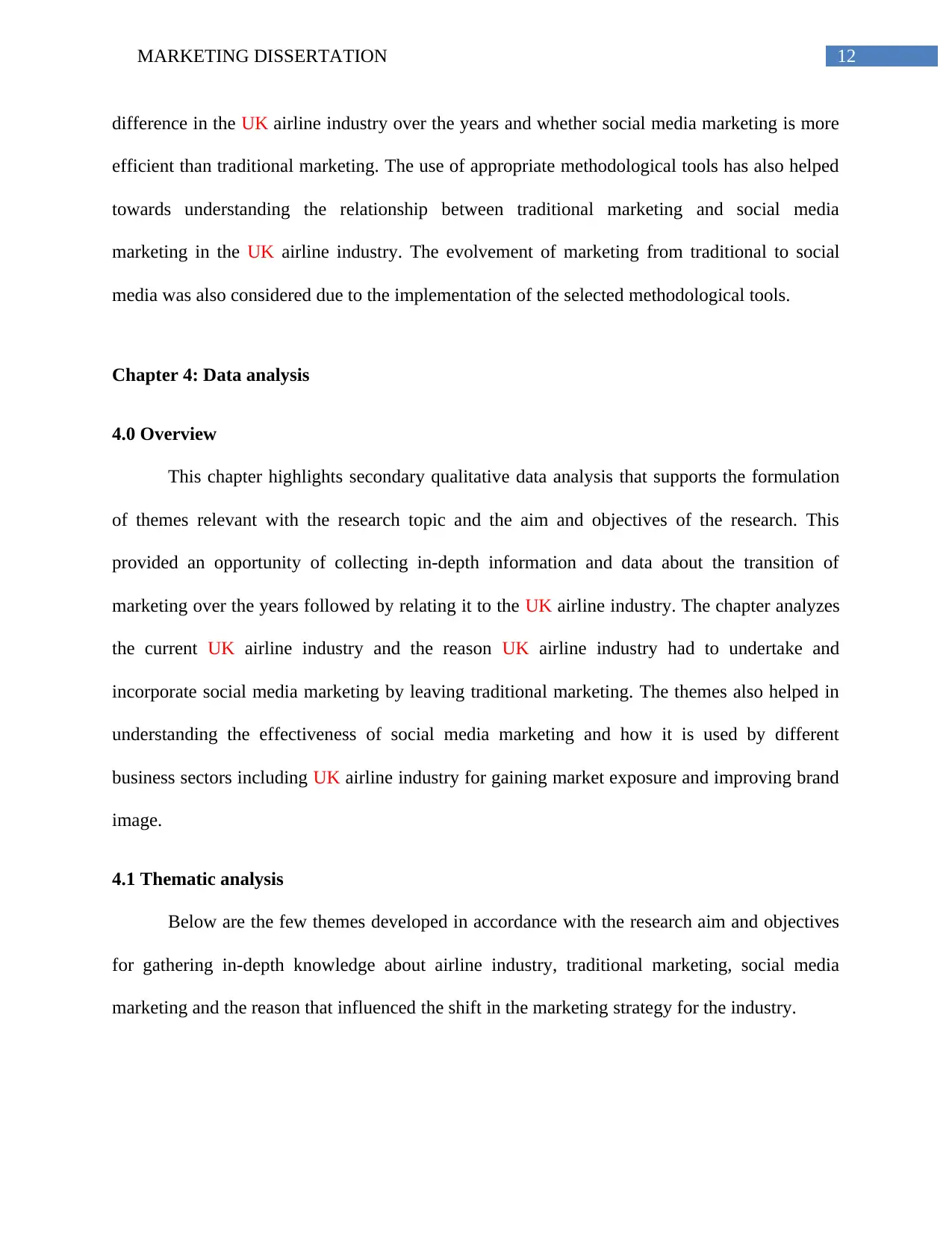
12MARKETING DISSERTATION
difference in the UK airline industry over the years and whether social media marketing is more
efficient than traditional marketing. The use of appropriate methodological tools has also helped
towards understanding the relationship between traditional marketing and social media
marketing in the UK airline industry. The evolvement of marketing from traditional to social
media was also considered due to the implementation of the selected methodological tools.
Chapter 4: Data analysis
4.0 Overview
This chapter highlights secondary qualitative data analysis that supports the formulation
of themes relevant with the research topic and the aim and objectives of the research. This
provided an opportunity of collecting in-depth information and data about the transition of
marketing over the years followed by relating it to the UK airline industry. The chapter analyzes
the current UK airline industry and the reason UK airline industry had to undertake and
incorporate social media marketing by leaving traditional marketing. The themes also helped in
understanding the effectiveness of social media marketing and how it is used by different
business sectors including UK airline industry for gaining market exposure and improving brand
image.
4.1 Thematic analysis
Below are the few themes developed in accordance with the research aim and objectives
for gathering in-depth knowledge about airline industry, traditional marketing, social media
marketing and the reason that influenced the shift in the marketing strategy for the industry.
difference in the UK airline industry over the years and whether social media marketing is more
efficient than traditional marketing. The use of appropriate methodological tools has also helped
towards understanding the relationship between traditional marketing and social media
marketing in the UK airline industry. The evolvement of marketing from traditional to social
media was also considered due to the implementation of the selected methodological tools.
Chapter 4: Data analysis
4.0 Overview
This chapter highlights secondary qualitative data analysis that supports the formulation
of themes relevant with the research topic and the aim and objectives of the research. This
provided an opportunity of collecting in-depth information and data about the transition of
marketing over the years followed by relating it to the UK airline industry. The chapter analyzes
the current UK airline industry and the reason UK airline industry had to undertake and
incorporate social media marketing by leaving traditional marketing. The themes also helped in
understanding the effectiveness of social media marketing and how it is used by different
business sectors including UK airline industry for gaining market exposure and improving brand
image.
4.1 Thematic analysis
Below are the few themes developed in accordance with the research aim and objectives
for gathering in-depth knowledge about airline industry, traditional marketing, social media
marketing and the reason that influenced the shift in the marketing strategy for the industry.
Paraphrase This Document
Need a fresh take? Get an instant paraphrase of this document with our AI Paraphraser

13MARKETING DISSERTATION
Theme 1: Current airlines industry in UK
The airline industry is growing rapidly and strongly because of the increased demand of
travelling through air. It is reported that around the world the number of people flying is
increased by 6.6% in the last two years. As mentioned by Zhang et al. (2014), the increased
demand of the airline industry is due to the increased demand of traveling for both personal and
professional purpose. However, as argued by Dai, Liu and Serfes (2014), people prefer to use
airline industry because the fares of the tickets have been reduced by the industry so that more
people can use the facility even for travelling short distances.
Figure 1: Top 15 airlines in UK International routes
(Source: Chow 2014)
Different business organizations in the airline industry are providing offers on their ticket fare
along with facilities such as free meals and hotel booking that is influencing the people to use the
service. This statement is further criticized by (Ciliberto and Williams 2014) that mentions that
fast paced life have increased the use of airline industry, as travelling by the sky requires short
Theme 1: Current airlines industry in UK
The airline industry is growing rapidly and strongly because of the increased demand of
travelling through air. It is reported that around the world the number of people flying is
increased by 6.6% in the last two years. As mentioned by Zhang et al. (2014), the increased
demand of the airline industry is due to the increased demand of traveling for both personal and
professional purpose. However, as argued by Dai, Liu and Serfes (2014), people prefer to use
airline industry because the fares of the tickets have been reduced by the industry so that more
people can use the facility even for travelling short distances.
Figure 1: Top 15 airlines in UK International routes
(Source: Chow 2014)
Different business organizations in the airline industry are providing offers on their ticket fare
along with facilities such as free meals and hotel booking that is influencing the people to use the
service. This statement is further criticized by (Ciliberto and Williams 2014) that mentions that
fast paced life have increased the use of airline industry, as travelling by the sky requires short
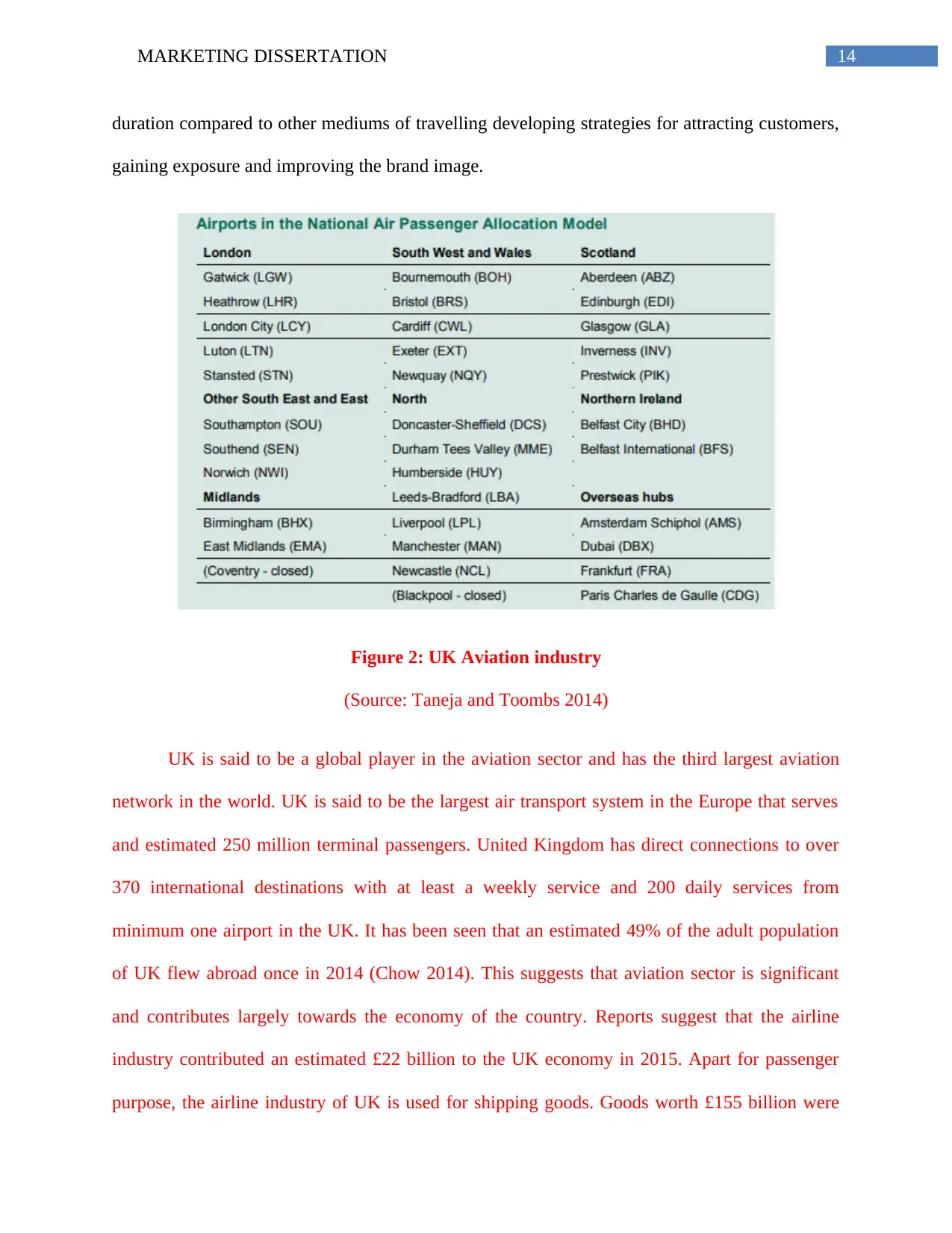
14MARKETING DISSERTATION
duration compared to other mediums of travelling developing strategies for attracting customers,
gaining exposure and improving the brand image.
Figure 2: UK Aviation industry
(Source: Taneja and Toombs 2014)
UK is said to be a global player in the aviation sector and has the third largest aviation
network in the world. UK is said to be the largest air transport system in the Europe that serves
and estimated 250 million terminal passengers. United Kingdom has direct connections to over
370 international destinations with at least a weekly service and 200 daily services from
minimum one airport in the UK. It has been seen that an estimated 49% of the adult population
of UK flew abroad once in 2014 (Chow 2014). This suggests that aviation sector is significant
and contributes largely towards the economy of the country. Reports suggest that the airline
industry contributed an estimated £22 billion to the UK economy in 2015. Apart for passenger
purpose, the airline industry of UK is used for shipping goods. Goods worth £155 billion were
duration compared to other mediums of travelling developing strategies for attracting customers,
gaining exposure and improving the brand image.
Figure 2: UK Aviation industry
(Source: Taneja and Toombs 2014)
UK is said to be a global player in the aviation sector and has the third largest aviation
network in the world. UK is said to be the largest air transport system in the Europe that serves
and estimated 250 million terminal passengers. United Kingdom has direct connections to over
370 international destinations with at least a weekly service and 200 daily services from
minimum one airport in the UK. It has been seen that an estimated 49% of the adult population
of UK flew abroad once in 2014 (Chow 2014). This suggests that aviation sector is significant
and contributes largely towards the economy of the country. Reports suggest that the airline
industry contributed an estimated £22 billion to the UK economy in 2015. Apart for passenger
purpose, the airline industry of UK is used for shipping goods. Goods worth £155 billion were
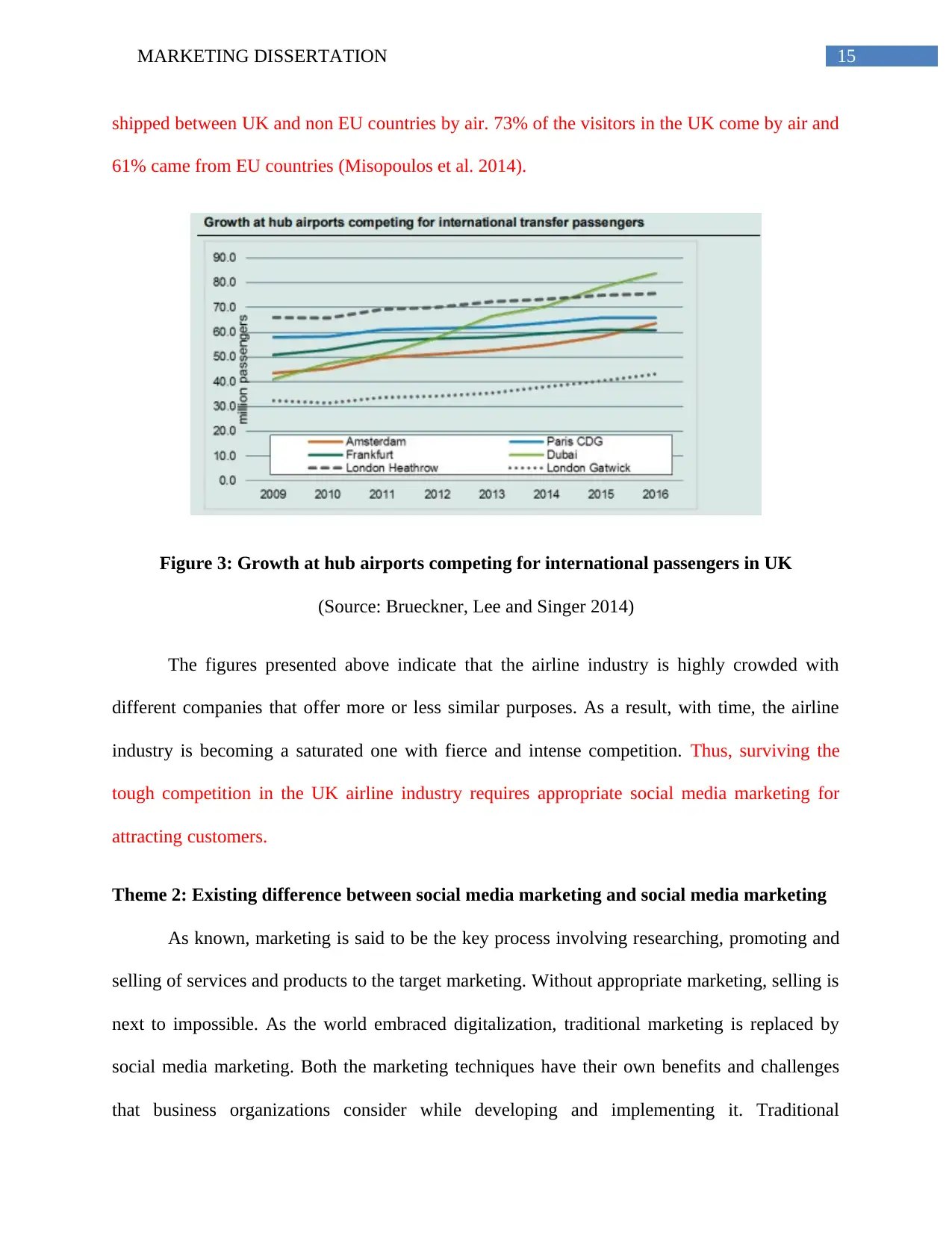
15MARKETING DISSERTATION
shipped between UK and non EU countries by air. 73% of the visitors in the UK come by air and
61% came from EU countries (Misopoulos et al. 2014).
Figure 3: Growth at hub airports competing for international passengers in UK
(Source: Brueckner, Lee and Singer 2014)
The figures presented above indicate that the airline industry is highly crowded with
different companies that offer more or less similar purposes. As a result, with time, the airline
industry is becoming a saturated one with fierce and intense competition. Thus, surviving the
tough competition in the UK airline industry requires appropriate social media marketing for
attracting customers.
Theme 2: Existing difference between social media marketing and social media marketing
As known, marketing is said to be the key process involving researching, promoting and
selling of services and products to the target marketing. Without appropriate marketing, selling is
next to impossible. As the world embraced digitalization, traditional marketing is replaced by
social media marketing. Both the marketing techniques have their own benefits and challenges
that business organizations consider while developing and implementing it. Traditional
shipped between UK and non EU countries by air. 73% of the visitors in the UK come by air and
61% came from EU countries (Misopoulos et al. 2014).
Figure 3: Growth at hub airports competing for international passengers in UK
(Source: Brueckner, Lee and Singer 2014)
The figures presented above indicate that the airline industry is highly crowded with
different companies that offer more or less similar purposes. As a result, with time, the airline
industry is becoming a saturated one with fierce and intense competition. Thus, surviving the
tough competition in the UK airline industry requires appropriate social media marketing for
attracting customers.
Theme 2: Existing difference between social media marketing and social media marketing
As known, marketing is said to be the key process involving researching, promoting and
selling of services and products to the target marketing. Without appropriate marketing, selling is
next to impossible. As the world embraced digitalization, traditional marketing is replaced by
social media marketing. Both the marketing techniques have their own benefits and challenges
that business organizations consider while developing and implementing it. Traditional
Secure Best Marks with AI Grader
Need help grading? Try our AI Grader for instant feedback on your assignments.

16MARKETING DISSERTATION
marketing is hardly practiced by business organizations, as it affects the sales, revenue and
customer base of the business organizations (Xu, Frankwick and Ramirez 2016).
Figure 4: Predicted growth of UK passengers
(Source: Xu, Frankwick and Ramirez 2016)
According to Todor (2016), traditional marketing helps in reaching local audiences
effectively by means of marketing tools such as newspapers, radios and pamphlets. Traditional
marketing is confined within a location due to which the marketing techniques are restricted to
particular location. In this case, the marketing procedures cannot be carried on outside location
as it becomes costly and time consuming. Here lies the difference between traditional and social
media marketing. However, as argued by Kotler, Kartajaya and Setiawan (2016), social media
marketing provides an opportunity of reaching out customers and conducting marketing
effectively without any restriction in terms of location. Social media marketing provides an
opportunity to target and communicate with vast audience regardless the location of the target
audiences. This is due to the virtual nature of the platform and using social media needs no
marketing is hardly practiced by business organizations, as it affects the sales, revenue and
customer base of the business organizations (Xu, Frankwick and Ramirez 2016).
Figure 4: Predicted growth of UK passengers
(Source: Xu, Frankwick and Ramirez 2016)
According to Todor (2016), traditional marketing helps in reaching local audiences
effectively by means of marketing tools such as newspapers, radios and pamphlets. Traditional
marketing is confined within a location due to which the marketing techniques are restricted to
particular location. In this case, the marketing procedures cannot be carried on outside location
as it becomes costly and time consuming. Here lies the difference between traditional and social
media marketing. However, as argued by Kotler, Kartajaya and Setiawan (2016), social media
marketing provides an opportunity of reaching out customers and conducting marketing
effectively without any restriction in terms of location. Social media marketing provides an
opportunity to target and communicate with vast audience regardless the location of the target
audiences. This is due to the virtual nature of the platform and using social media needs no
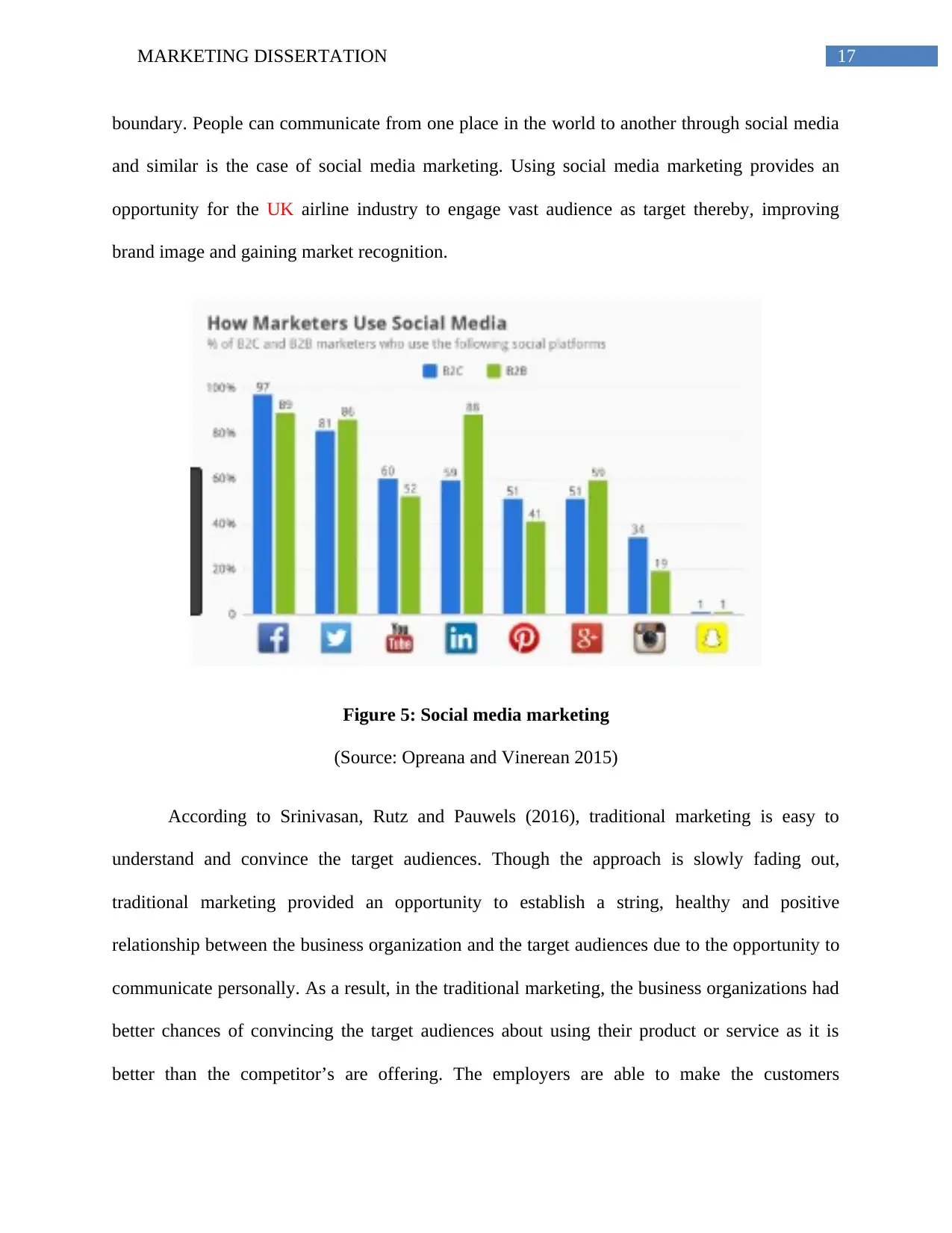
17MARKETING DISSERTATION
boundary. People can communicate from one place in the world to another through social media
and similar is the case of social media marketing. Using social media marketing provides an
opportunity for the UK airline industry to engage vast audience as target thereby, improving
brand image and gaining market recognition.
Figure 5: Social media marketing
(Source: Opreana and Vinerean 2015)
According to Srinivasan, Rutz and Pauwels (2016), traditional marketing is easy to
understand and convince the target audiences. Though the approach is slowly fading out,
traditional marketing provided an opportunity to establish a string, healthy and positive
relationship between the business organization and the target audiences due to the opportunity to
communicate personally. As a result, in the traditional marketing, the business organizations had
better chances of convincing the target audiences about using their product or service as it is
better than the competitor’s are offering. The employers are able to make the customers
boundary. People can communicate from one place in the world to another through social media
and similar is the case of social media marketing. Using social media marketing provides an
opportunity for the UK airline industry to engage vast audience as target thereby, improving
brand image and gaining market recognition.
Figure 5: Social media marketing
(Source: Opreana and Vinerean 2015)
According to Srinivasan, Rutz and Pauwels (2016), traditional marketing is easy to
understand and convince the target audiences. Though the approach is slowly fading out,
traditional marketing provided an opportunity to establish a string, healthy and positive
relationship between the business organization and the target audiences due to the opportunity to
communicate personally. As a result, in the traditional marketing, the business organizations had
better chances of convincing the target audiences about using their product or service as it is
better than the competitor’s are offering. The employers are able to make the customers

18MARKETING DISSERTATION
confident and develop trust on them that is not possible for social media marketing. However,
the process of customer engagement is not a continuous process for traditional marketing, as the
business organization lack effective medium to ensure communication constantly. However, as
argued by Opreana and Vinerean (2015), social media marketing is more engaging compared to
traditional marketing. Though social media marketing lacks personal touch, it is more engaging.
The use of social media platforms provides an opportunity to engage effectively by live chat,
email, commenting and sharing thereby, making the customers aware of the latest information
and updates without any delay. Considering the business competition in the UK airline industry,
social media marketing provides an opportunity of the UK airline industry to keep the target
audiences posted and information continuously regardless of time and location.
Theme 3: Issues in traditional marketing
The world has embraced digitalization rapidly that changed the concept of marketing for
the various industries. The existence of the issues in traditional marketing resulted in the shift of
traditional marketing to social media marketing. As commented by Shankar et al. (2016), time is
a major issue in traditional marketing. This is because the use of static texts is seen in traditional
marketing for promoting services and products. As a result, once an advertisement is placed, it
cannot be changed until a new request for changing it is placed. For example, if the UK airline
industry want to sale tickets at cheap price and put it on newspaper and run out of the tickets due
to minimal price, the customers coming after that are left unsatisfied. This is because due to
traditional marketing, a request needs to be placed stating they are out of tickets that is printed in
the newspaper the next day thereby, justifying the process to be time consuming. However, for
social media marketing, such information is updated instantly on the social media platform page
thereby, showing that it is time efficient.
confident and develop trust on them that is not possible for social media marketing. However,
the process of customer engagement is not a continuous process for traditional marketing, as the
business organization lack effective medium to ensure communication constantly. However, as
argued by Opreana and Vinerean (2015), social media marketing is more engaging compared to
traditional marketing. Though social media marketing lacks personal touch, it is more engaging.
The use of social media platforms provides an opportunity to engage effectively by live chat,
email, commenting and sharing thereby, making the customers aware of the latest information
and updates without any delay. Considering the business competition in the UK airline industry,
social media marketing provides an opportunity of the UK airline industry to keep the target
audiences posted and information continuously regardless of time and location.
Theme 3: Issues in traditional marketing
The world has embraced digitalization rapidly that changed the concept of marketing for
the various industries. The existence of the issues in traditional marketing resulted in the shift of
traditional marketing to social media marketing. As commented by Shankar et al. (2016), time is
a major issue in traditional marketing. This is because the use of static texts is seen in traditional
marketing for promoting services and products. As a result, once an advertisement is placed, it
cannot be changed until a new request for changing it is placed. For example, if the UK airline
industry want to sale tickets at cheap price and put it on newspaper and run out of the tickets due
to minimal price, the customers coming after that are left unsatisfied. This is because due to
traditional marketing, a request needs to be placed stating they are out of tickets that is printed in
the newspaper the next day thereby, justifying the process to be time consuming. However, for
social media marketing, such information is updated instantly on the social media platform page
thereby, showing that it is time efficient.
Paraphrase This Document
Need a fresh take? Get an instant paraphrase of this document with our AI Paraphraser
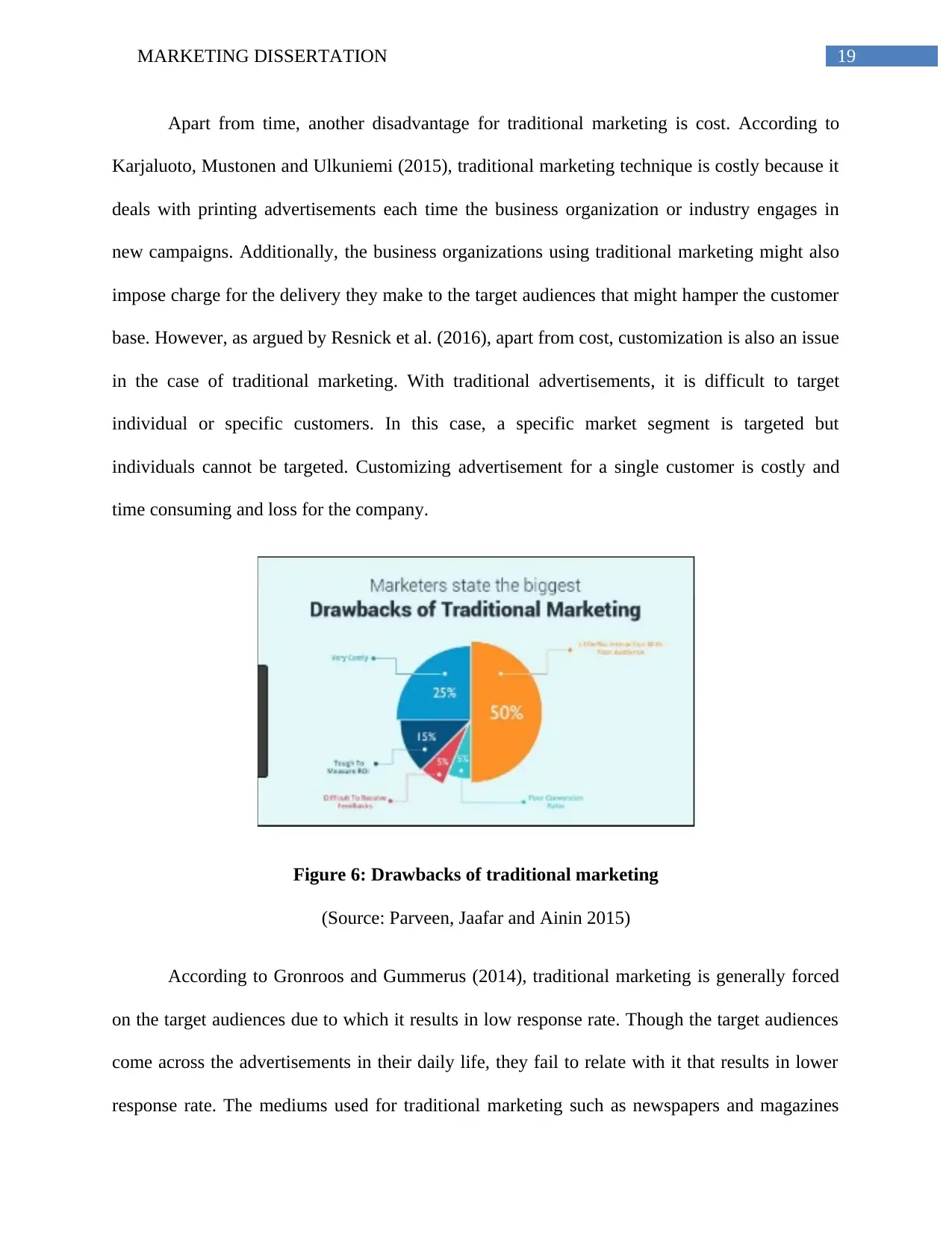
19MARKETING DISSERTATION
Apart from time, another disadvantage for traditional marketing is cost. According to
Karjaluoto, Mustonen and Ulkuniemi (2015), traditional marketing technique is costly because it
deals with printing advertisements each time the business organization or industry engages in
new campaigns. Additionally, the business organizations using traditional marketing might also
impose charge for the delivery they make to the target audiences that might hamper the customer
base. However, as argued by Resnick et al. (2016), apart from cost, customization is also an issue
in the case of traditional marketing. With traditional advertisements, it is difficult to target
individual or specific customers. In this case, a specific market segment is targeted but
individuals cannot be targeted. Customizing advertisement for a single customer is costly and
time consuming and loss for the company.
Figure 6: Drawbacks of traditional marketing
(Source: Parveen, Jaafar and Ainin 2015)
According to Gronroos and Gummerus (2014), traditional marketing is generally forced
on the target audiences due to which it results in low response rate. Though the target audiences
come across the advertisements in their daily life, they fail to relate with it that results in lower
response rate. The mediums used for traditional marketing such as newspapers and magazines
Apart from time, another disadvantage for traditional marketing is cost. According to
Karjaluoto, Mustonen and Ulkuniemi (2015), traditional marketing technique is costly because it
deals with printing advertisements each time the business organization or industry engages in
new campaigns. Additionally, the business organizations using traditional marketing might also
impose charge for the delivery they make to the target audiences that might hamper the customer
base. However, as argued by Resnick et al. (2016), apart from cost, customization is also an issue
in the case of traditional marketing. With traditional advertisements, it is difficult to target
individual or specific customers. In this case, a specific market segment is targeted but
individuals cannot be targeted. Customizing advertisement for a single customer is costly and
time consuming and loss for the company.
Figure 6: Drawbacks of traditional marketing
(Source: Parveen, Jaafar and Ainin 2015)
According to Gronroos and Gummerus (2014), traditional marketing is generally forced
on the target audiences due to which it results in low response rate. Though the target audiences
come across the advertisements in their daily life, they fail to relate with it that results in lower
response rate. The mediums used for traditional marketing such as newspapers and magazines
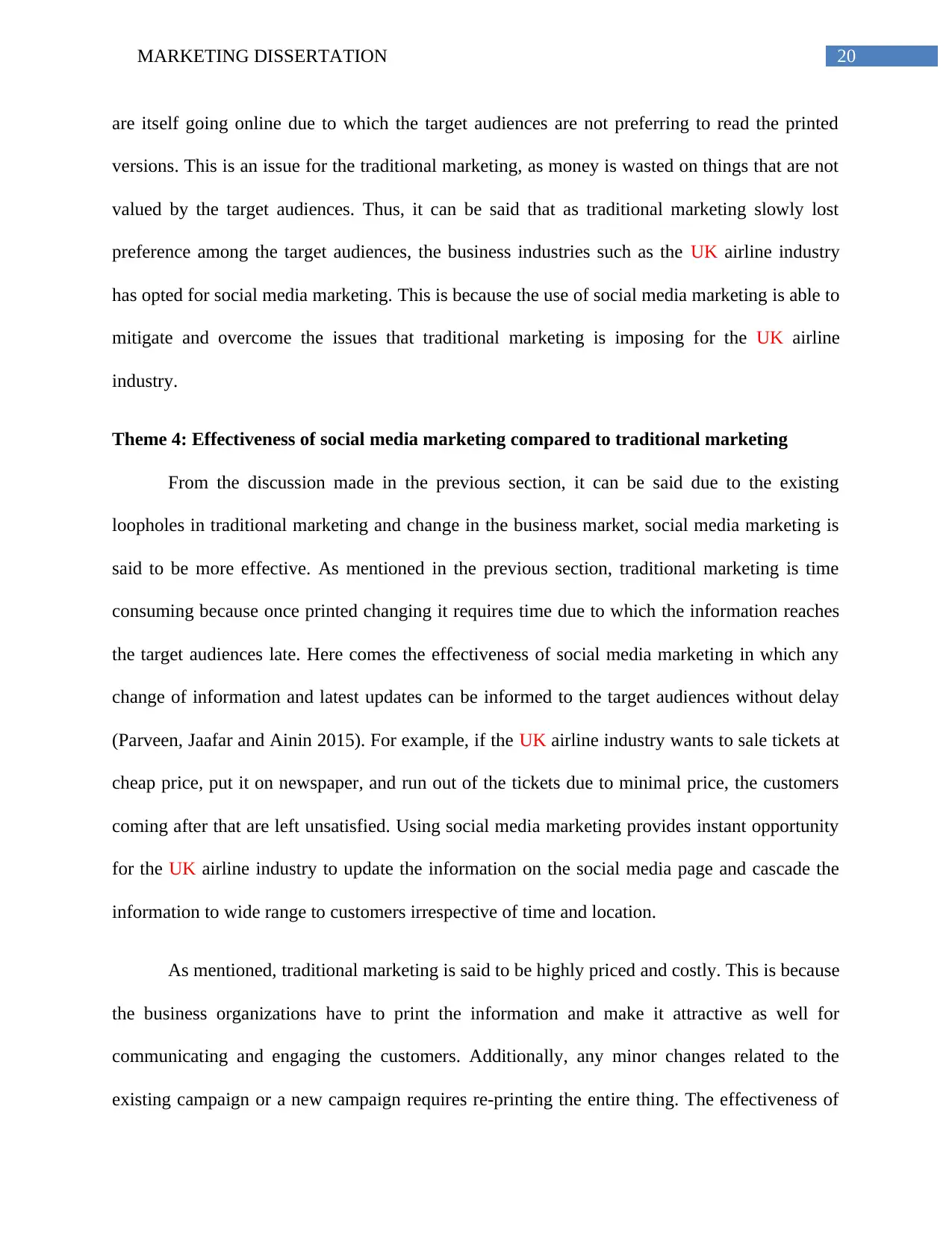
20MARKETING DISSERTATION
are itself going online due to which the target audiences are not preferring to read the printed
versions. This is an issue for the traditional marketing, as money is wasted on things that are not
valued by the target audiences. Thus, it can be said that as traditional marketing slowly lost
preference among the target audiences, the business industries such as the UK airline industry
has opted for social media marketing. This is because the use of social media marketing is able to
mitigate and overcome the issues that traditional marketing is imposing for the UK airline
industry.
Theme 4: Effectiveness of social media marketing compared to traditional marketing
From the discussion made in the previous section, it can be said due to the existing
loopholes in traditional marketing and change in the business market, social media marketing is
said to be more effective. As mentioned in the previous section, traditional marketing is time
consuming because once printed changing it requires time due to which the information reaches
the target audiences late. Here comes the effectiveness of social media marketing in which any
change of information and latest updates can be informed to the target audiences without delay
(Parveen, Jaafar and Ainin 2015). For example, if the UK airline industry wants to sale tickets at
cheap price, put it on newspaper, and run out of the tickets due to minimal price, the customers
coming after that are left unsatisfied. Using social media marketing provides instant opportunity
for the UK airline industry to update the information on the social media page and cascade the
information to wide range to customers irrespective of time and location.
As mentioned, traditional marketing is said to be highly priced and costly. This is because
the business organizations have to print the information and make it attractive as well for
communicating and engaging the customers. Additionally, any minor changes related to the
existing campaign or a new campaign requires re-printing the entire thing. The effectiveness of
are itself going online due to which the target audiences are not preferring to read the printed
versions. This is an issue for the traditional marketing, as money is wasted on things that are not
valued by the target audiences. Thus, it can be said that as traditional marketing slowly lost
preference among the target audiences, the business industries such as the UK airline industry
has opted for social media marketing. This is because the use of social media marketing is able to
mitigate and overcome the issues that traditional marketing is imposing for the UK airline
industry.
Theme 4: Effectiveness of social media marketing compared to traditional marketing
From the discussion made in the previous section, it can be said due to the existing
loopholes in traditional marketing and change in the business market, social media marketing is
said to be more effective. As mentioned in the previous section, traditional marketing is time
consuming because once printed changing it requires time due to which the information reaches
the target audiences late. Here comes the effectiveness of social media marketing in which any
change of information and latest updates can be informed to the target audiences without delay
(Parveen, Jaafar and Ainin 2015). For example, if the UK airline industry wants to sale tickets at
cheap price, put it on newspaper, and run out of the tickets due to minimal price, the customers
coming after that are left unsatisfied. Using social media marketing provides instant opportunity
for the UK airline industry to update the information on the social media page and cascade the
information to wide range to customers irrespective of time and location.
As mentioned, traditional marketing is said to be highly priced and costly. This is because
the business organizations have to print the information and make it attractive as well for
communicating and engaging the customers. Additionally, any minor changes related to the
existing campaign or a new campaign requires re-printing the entire thing. The effectiveness of
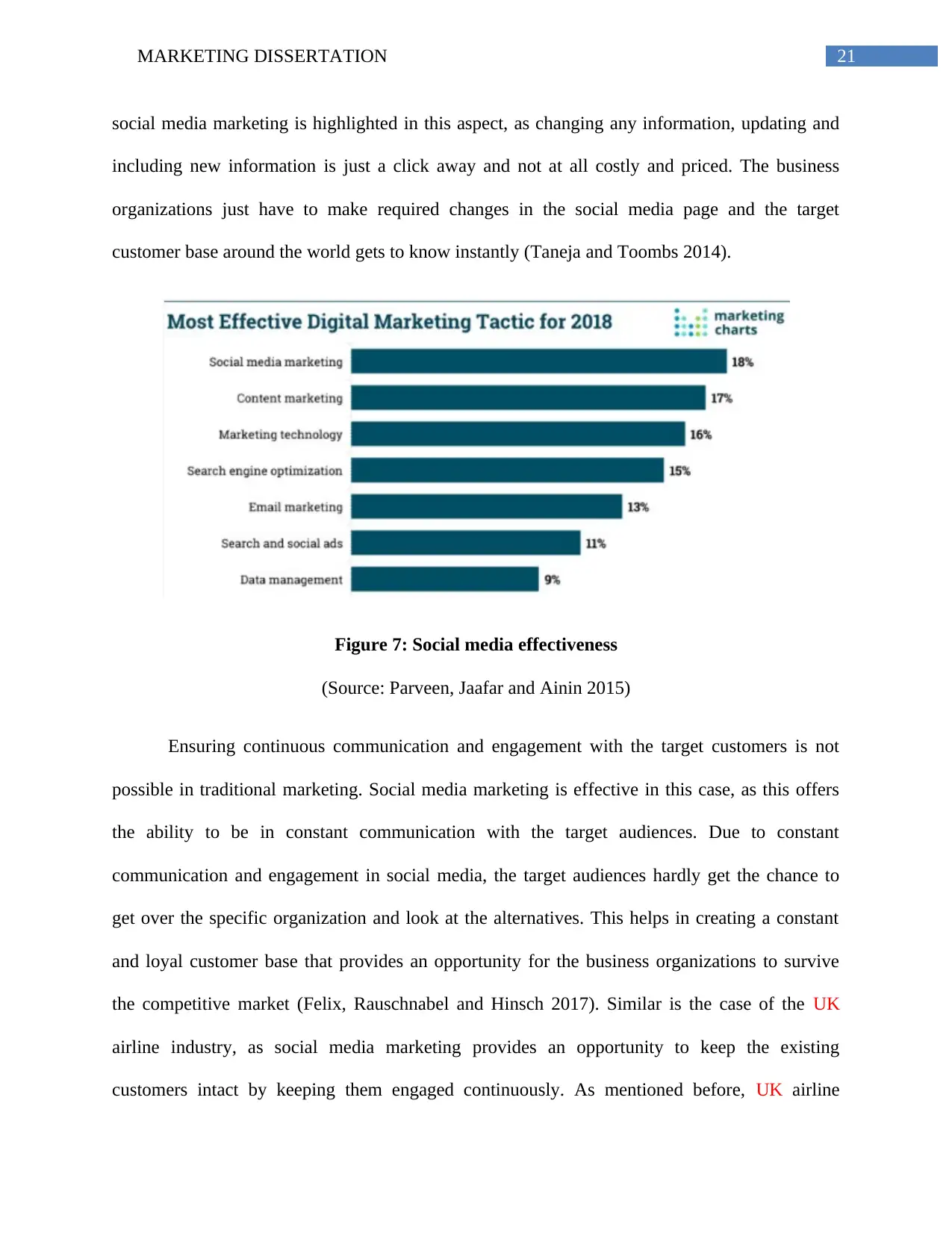
21MARKETING DISSERTATION
social media marketing is highlighted in this aspect, as changing any information, updating and
including new information is just a click away and not at all costly and priced. The business
organizations just have to make required changes in the social media page and the target
customer base around the world gets to know instantly (Taneja and Toombs 2014).
Figure 7: Social media effectiveness
(Source: Parveen, Jaafar and Ainin 2015)
Ensuring continuous communication and engagement with the target customers is not
possible in traditional marketing. Social media marketing is effective in this case, as this offers
the ability to be in constant communication with the target audiences. Due to constant
communication and engagement in social media, the target audiences hardly get the chance to
get over the specific organization and look at the alternatives. This helps in creating a constant
and loyal customer base that provides an opportunity for the business organizations to survive
the competitive market (Felix, Rauschnabel and Hinsch 2017). Similar is the case of the UK
airline industry, as social media marketing provides an opportunity to keep the existing
customers intact by keeping them engaged continuously. As mentioned before, UK airline
social media marketing is highlighted in this aspect, as changing any information, updating and
including new information is just a click away and not at all costly and priced. The business
organizations just have to make required changes in the social media page and the target
customer base around the world gets to know instantly (Taneja and Toombs 2014).
Figure 7: Social media effectiveness
(Source: Parveen, Jaafar and Ainin 2015)
Ensuring continuous communication and engagement with the target customers is not
possible in traditional marketing. Social media marketing is effective in this case, as this offers
the ability to be in constant communication with the target audiences. Due to constant
communication and engagement in social media, the target audiences hardly get the chance to
get over the specific organization and look at the alternatives. This helps in creating a constant
and loyal customer base that provides an opportunity for the business organizations to survive
the competitive market (Felix, Rauschnabel and Hinsch 2017). Similar is the case of the UK
airline industry, as social media marketing provides an opportunity to keep the existing
customers intact by keeping them engaged continuously. As mentioned before, UK airline
Secure Best Marks with AI Grader
Need help grading? Try our AI Grader for instant feedback on your assignments.
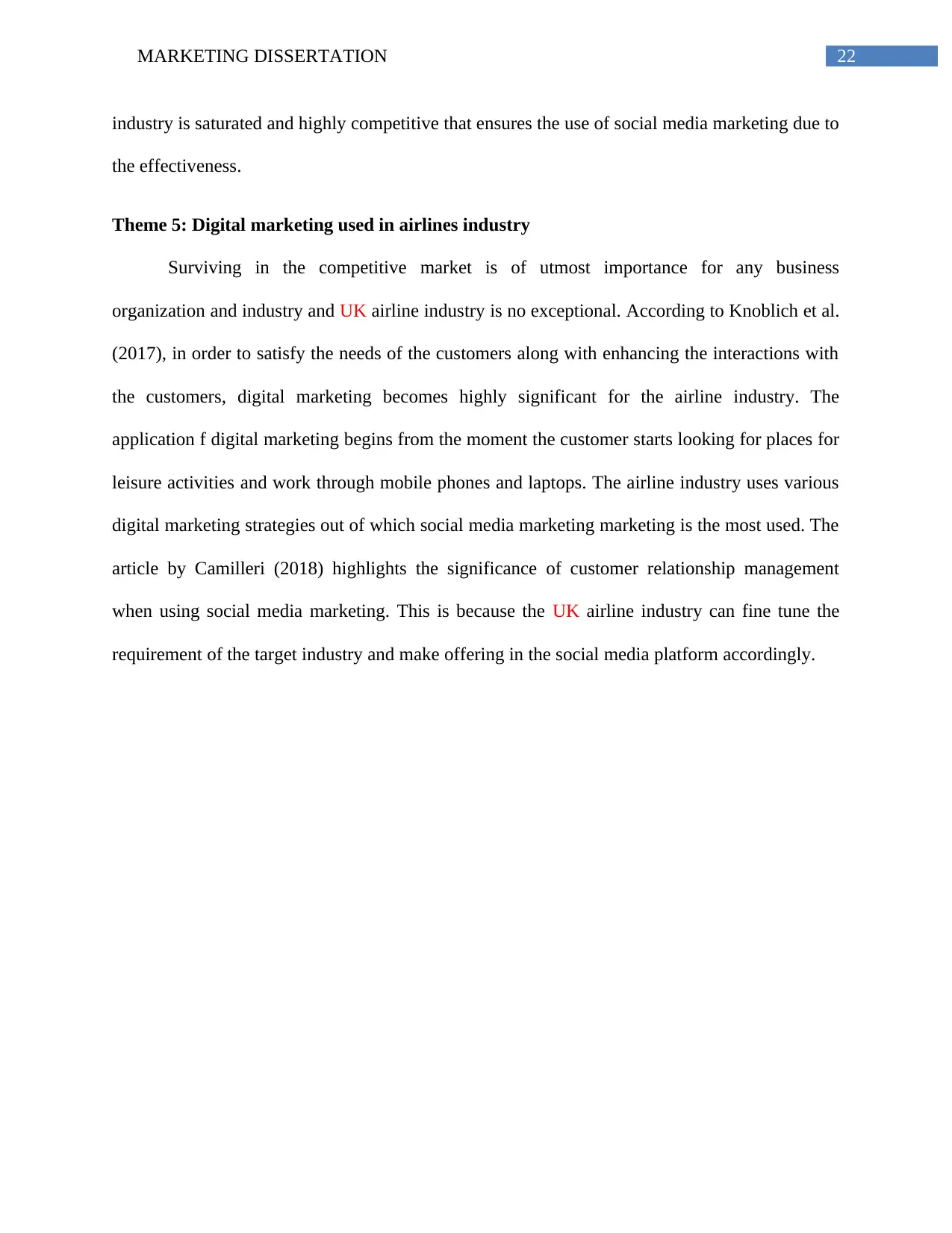
22MARKETING DISSERTATION
industry is saturated and highly competitive that ensures the use of social media marketing due to
the effectiveness.
Theme 5: Digital marketing used in airlines industry
Surviving in the competitive market is of utmost importance for any business
organization and industry and UK airline industry is no exceptional. According to Knoblich et al.
(2017), in order to satisfy the needs of the customers along with enhancing the interactions with
the customers, digital marketing becomes highly significant for the airline industry. The
application f digital marketing begins from the moment the customer starts looking for places for
leisure activities and work through mobile phones and laptops. The airline industry uses various
digital marketing strategies out of which social media marketing marketing is the most used. The
article by Camilleri (2018) highlights the significance of customer relationship management
when using social media marketing. This is because the UK airline industry can fine tune the
requirement of the target industry and make offering in the social media platform accordingly.
industry is saturated and highly competitive that ensures the use of social media marketing due to
the effectiveness.
Theme 5: Digital marketing used in airlines industry
Surviving in the competitive market is of utmost importance for any business
organization and industry and UK airline industry is no exceptional. According to Knoblich et al.
(2017), in order to satisfy the needs of the customers along with enhancing the interactions with
the customers, digital marketing becomes highly significant for the airline industry. The
application f digital marketing begins from the moment the customer starts looking for places for
leisure activities and work through mobile phones and laptops. The airline industry uses various
digital marketing strategies out of which social media marketing marketing is the most used. The
article by Camilleri (2018) highlights the significance of customer relationship management
when using social media marketing. This is because the UK airline industry can fine tune the
requirement of the target industry and make offering in the social media platform accordingly.

23MARKETING DISSERTATION
Figure 8: Digital marketing in UK airline industry
(Source: Hudson and Hudson 2017)
There is no denying to the fact that airline industry is a rapidly growing sector and digital
marketing has contributed largely for its rapid growth. The use of digital marketing helped in
totally shaping the business in the way that facilitates maximum profit and better results. As
mentioned by Egol, Peterson and Stroh (2014), the use digital marketing provides an opportunity
for the airline industry to get a sales hike and thrives to grow. Thus, it can be said that being
active in the social media platform allows the UK airline industry to be in demand along with
providing an opportunity to improve the brand image, market exposure and brand reputation.
Top UK airline companies in the industry that uses digital marketing has millions of fans
in their social media platform. This is because majority of the population uses the social media
for communicating and looking for updates for different business organizations. As a result, it is
Figure 8: Digital marketing in UK airline industry
(Source: Hudson and Hudson 2017)
There is no denying to the fact that airline industry is a rapidly growing sector and digital
marketing has contributed largely for its rapid growth. The use of digital marketing helped in
totally shaping the business in the way that facilitates maximum profit and better results. As
mentioned by Egol, Peterson and Stroh (2014), the use digital marketing provides an opportunity
for the airline industry to get a sales hike and thrives to grow. Thus, it can be said that being
active in the social media platform allows the UK airline industry to be in demand along with
providing an opportunity to improve the brand image, market exposure and brand reputation.
Top UK airline companies in the industry that uses digital marketing has millions of fans
in their social media platform. This is because majority of the population uses the social media
for communicating and looking for updates for different business organizations. As a result, it is
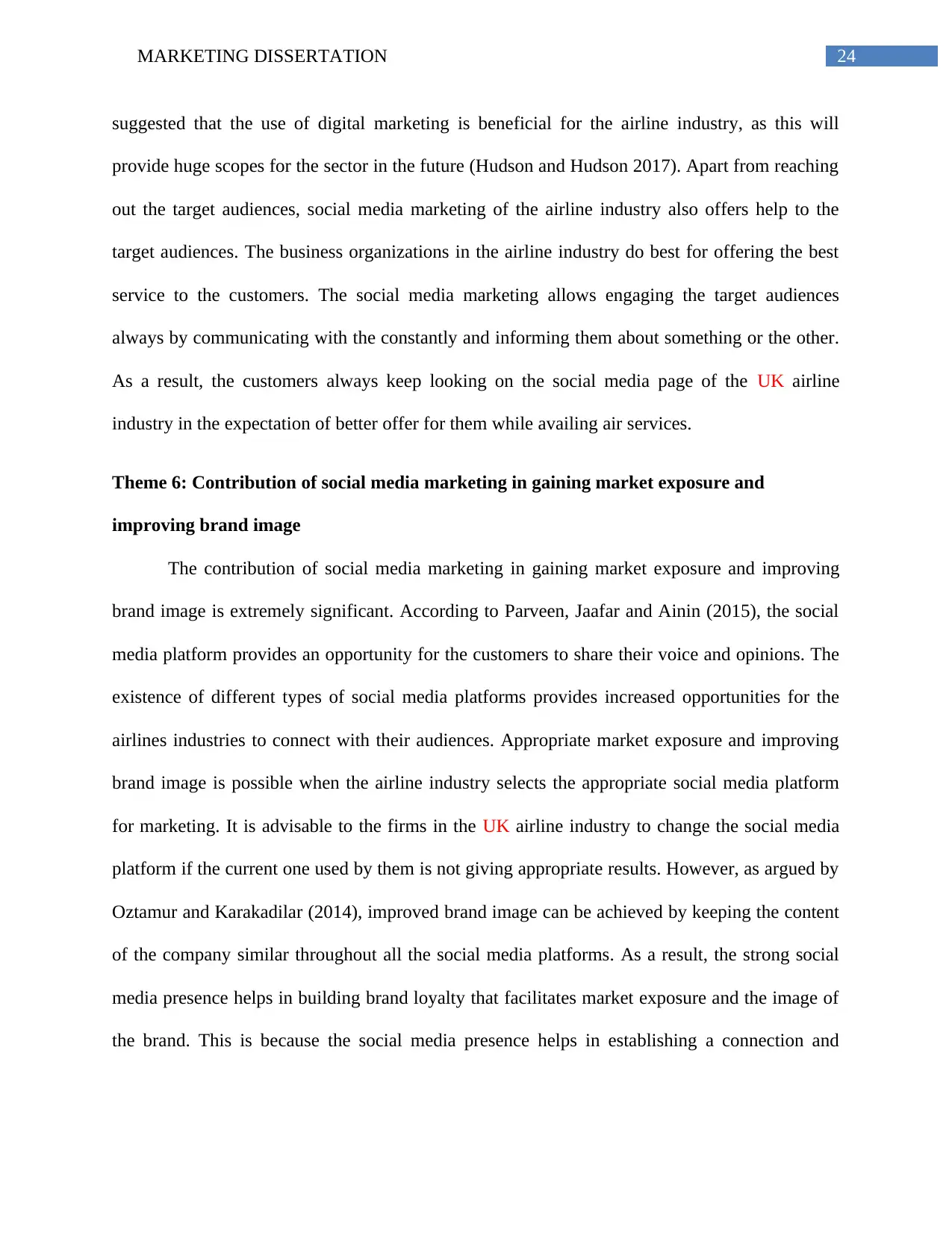
24MARKETING DISSERTATION
suggested that the use of digital marketing is beneficial for the airline industry, as this will
provide huge scopes for the sector in the future (Hudson and Hudson 2017). Apart from reaching
out the target audiences, social media marketing of the airline industry also offers help to the
target audiences. The business organizations in the airline industry do best for offering the best
service to the customers. The social media marketing allows engaging the target audiences
always by communicating with the constantly and informing them about something or the other.
As a result, the customers always keep looking on the social media page of the UK airline
industry in the expectation of better offer for them while availing air services.
Theme 6: Contribution of social media marketing in gaining market exposure and
improving brand image
The contribution of social media marketing in gaining market exposure and improving
brand image is extremely significant. According to Parveen, Jaafar and Ainin (2015), the social
media platform provides an opportunity for the customers to share their voice and opinions. The
existence of different types of social media platforms provides increased opportunities for the
airlines industries to connect with their audiences. Appropriate market exposure and improving
brand image is possible when the airline industry selects the appropriate social media platform
for marketing. It is advisable to the firms in the UK airline industry to change the social media
platform if the current one used by them is not giving appropriate results. However, as argued by
Oztamur and Karakadilar (2014), improved brand image can be achieved by keeping the content
of the company similar throughout all the social media platforms. As a result, the strong social
media presence helps in building brand loyalty that facilitates market exposure and the image of
the brand. This is because the social media presence helps in establishing a connection and
suggested that the use of digital marketing is beneficial for the airline industry, as this will
provide huge scopes for the sector in the future (Hudson and Hudson 2017). Apart from reaching
out the target audiences, social media marketing of the airline industry also offers help to the
target audiences. The business organizations in the airline industry do best for offering the best
service to the customers. The social media marketing allows engaging the target audiences
always by communicating with the constantly and informing them about something or the other.
As a result, the customers always keep looking on the social media page of the UK airline
industry in the expectation of better offer for them while availing air services.
Theme 6: Contribution of social media marketing in gaining market exposure and
improving brand image
The contribution of social media marketing in gaining market exposure and improving
brand image is extremely significant. According to Parveen, Jaafar and Ainin (2015), the social
media platform provides an opportunity for the customers to share their voice and opinions. The
existence of different types of social media platforms provides increased opportunities for the
airlines industries to connect with their audiences. Appropriate market exposure and improving
brand image is possible when the airline industry selects the appropriate social media platform
for marketing. It is advisable to the firms in the UK airline industry to change the social media
platform if the current one used by them is not giving appropriate results. However, as argued by
Oztamur and Karakadilar (2014), improved brand image can be achieved by keeping the content
of the company similar throughout all the social media platforms. As a result, the strong social
media presence helps in building brand loyalty that facilitates market exposure and the image of
the brand. This is because the social media presence helps in establishing a connection and
Paraphrase This Document
Need a fresh take? Get an instant paraphrase of this document with our AI Paraphraser

25MARKETING DISSERTATION
rapport, as the industry takes adequate time to provide the users with useful and important
information along with help and support without asking anything in return.
Figure 9: Effectiveness of social media marketing
(Source: Lacka and Chong 2016)
As mentioned by Karimi and Naghibi (2015), wide market exposure and improved brand
image can be obtained by social media marketing by creating value and relationship with the
customers. As the UK airline industry is communicating with the customers constantly, it tends
to create a positive relationship with the industry and the company. As a result, both the parties
are able to share relevant and valuable information about each other and ensure that the
information are taken care of and considered while planning offers and campaigns. Being
constantly in the eye of the customers and fulfilling their needs and demands helps in improving
the brand image. Social media marketing also helps in communicating with people regardless of
the location and provides those offers according to their needs thereby, ensuring market exposure
rapport, as the industry takes adequate time to provide the users with useful and important
information along with help and support without asking anything in return.
Figure 9: Effectiveness of social media marketing
(Source: Lacka and Chong 2016)
As mentioned by Karimi and Naghibi (2015), wide market exposure and improved brand
image can be obtained by social media marketing by creating value and relationship with the
customers. As the UK airline industry is communicating with the customers constantly, it tends
to create a positive relationship with the industry and the company. As a result, both the parties
are able to share relevant and valuable information about each other and ensure that the
information are taken care of and considered while planning offers and campaigns. Being
constantly in the eye of the customers and fulfilling their needs and demands helps in improving
the brand image. Social media marketing also helps in communicating with people regardless of
the location and provides those offers according to their needs thereby, ensuring market exposure

26MARKETING DISSERTATION
(Lacka and Chong 2016). Having adequate and sufficient market exposure is important for the
airline industry in order to survive the tough and intense market.
4.2 Summary
Thus, it can be summarized that technology advancement over the years lead to the
transition of traditional marketing from social media marketing. Globalization facilitated
increased competition in the UK airline industry that enforced the industry to undertake social
media marketing for gaining more exposure and improving brand image. Social media marketing
is said to be more effective because it is one of the most cost effective ways of increasing the
visibility of the business. Though traditional marketing offer advantages to the UK airline
industry such as reaching out local target audiences but tough competition in the UK airline
industry requires global expansion and recognition that is possible due to the use social media
marketing only, as vast audience can be targeted, effective brand building, getting results
instantly, being cost effective and more engaging.
(Lacka and Chong 2016). Having adequate and sufficient market exposure is important for the
airline industry in order to survive the tough and intense market.
4.2 Summary
Thus, it can be summarized that technology advancement over the years lead to the
transition of traditional marketing from social media marketing. Globalization facilitated
increased competition in the UK airline industry that enforced the industry to undertake social
media marketing for gaining more exposure and improving brand image. Social media marketing
is said to be more effective because it is one of the most cost effective ways of increasing the
visibility of the business. Though traditional marketing offer advantages to the UK airline
industry such as reaching out local target audiences but tough competition in the UK airline
industry requires global expansion and recognition that is possible due to the use social media
marketing only, as vast audience can be targeted, effective brand building, getting results
instantly, being cost effective and more engaging.
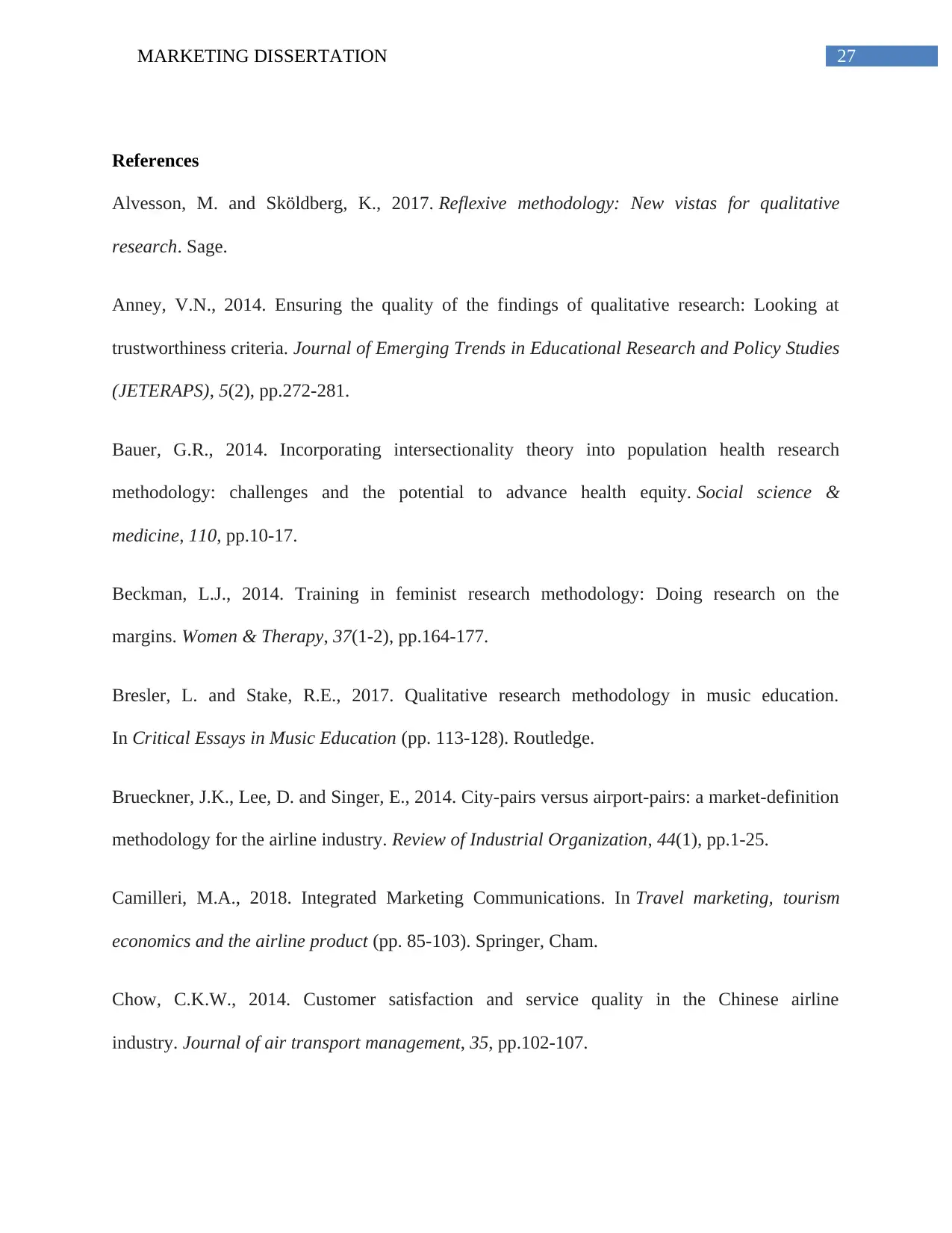
27MARKETING DISSERTATION
References
Alvesson, M. and Sköldberg, K., 2017. Reflexive methodology: New vistas for qualitative
research. Sage.
Anney, V.N., 2014. Ensuring the quality of the findings of qualitative research: Looking at
trustworthiness criteria. Journal of Emerging Trends in Educational Research and Policy Studies
(JETERAPS), 5(2), pp.272-281.
Bauer, G.R., 2014. Incorporating intersectionality theory into population health research
methodology: challenges and the potential to advance health equity. Social science &
medicine, 110, pp.10-17.
Beckman, L.J., 2014. Training in feminist research methodology: Doing research on the
margins. Women & Therapy, 37(1-2), pp.164-177.
Bresler, L. and Stake, R.E., 2017. Qualitative research methodology in music education.
In Critical Essays in Music Education (pp. 113-128). Routledge.
Brueckner, J.K., Lee, D. and Singer, E., 2014. City-pairs versus airport-pairs: a market-definition
methodology for the airline industry. Review of Industrial Organization, 44(1), pp.1-25.
Camilleri, M.A., 2018. Integrated Marketing Communications. In Travel marketing, tourism
economics and the airline product (pp. 85-103). Springer, Cham.
Chow, C.K.W., 2014. Customer satisfaction and service quality in the Chinese airline
industry. Journal of air transport management, 35, pp.102-107.
References
Alvesson, M. and Sköldberg, K., 2017. Reflexive methodology: New vistas for qualitative
research. Sage.
Anney, V.N., 2014. Ensuring the quality of the findings of qualitative research: Looking at
trustworthiness criteria. Journal of Emerging Trends in Educational Research and Policy Studies
(JETERAPS), 5(2), pp.272-281.
Bauer, G.R., 2014. Incorporating intersectionality theory into population health research
methodology: challenges and the potential to advance health equity. Social science &
medicine, 110, pp.10-17.
Beckman, L.J., 2014. Training in feminist research methodology: Doing research on the
margins. Women & Therapy, 37(1-2), pp.164-177.
Bresler, L. and Stake, R.E., 2017. Qualitative research methodology in music education.
In Critical Essays in Music Education (pp. 113-128). Routledge.
Brueckner, J.K., Lee, D. and Singer, E., 2014. City-pairs versus airport-pairs: a market-definition
methodology for the airline industry. Review of Industrial Organization, 44(1), pp.1-25.
Camilleri, M.A., 2018. Integrated Marketing Communications. In Travel marketing, tourism
economics and the airline product (pp. 85-103). Springer, Cham.
Chow, C.K.W., 2014. Customer satisfaction and service quality in the Chinese airline
industry. Journal of air transport management, 35, pp.102-107.
Secure Best Marks with AI Grader
Need help grading? Try our AI Grader for instant feedback on your assignments.
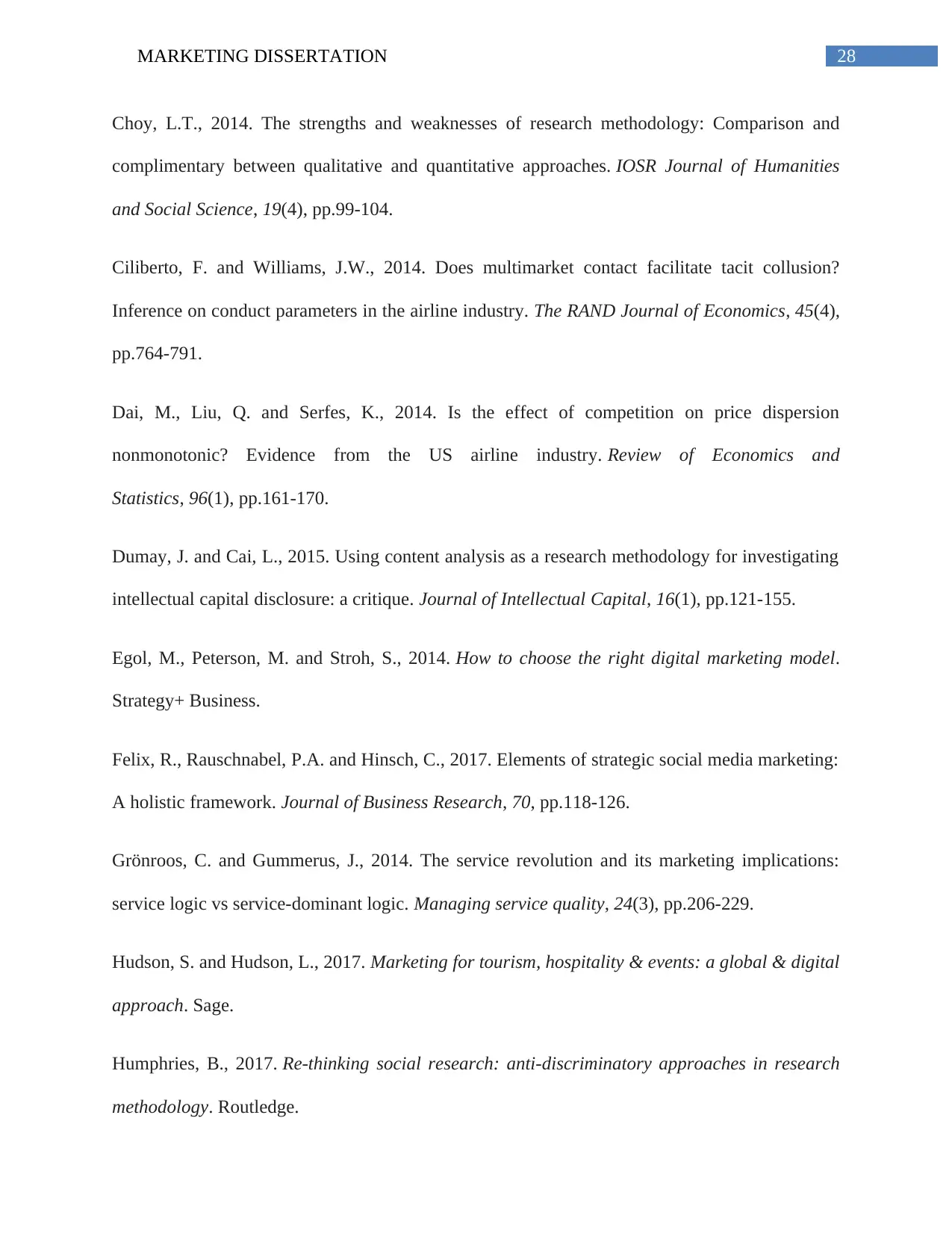
28MARKETING DISSERTATION
Choy, L.T., 2014. The strengths and weaknesses of research methodology: Comparison and
complimentary between qualitative and quantitative approaches. IOSR Journal of Humanities
and Social Science, 19(4), pp.99-104.
Ciliberto, F. and Williams, J.W., 2014. Does multimarket contact facilitate tacit collusion?
Inference on conduct parameters in the airline industry. The RAND Journal of Economics, 45(4),
pp.764-791.
Dai, M., Liu, Q. and Serfes, K., 2014. Is the effect of competition on price dispersion
nonmonotonic? Evidence from the US airline industry. Review of Economics and
Statistics, 96(1), pp.161-170.
Dumay, J. and Cai, L., 2015. Using content analysis as a research methodology for investigating
intellectual capital disclosure: a critique. Journal of Intellectual Capital, 16(1), pp.121-155.
Egol, M., Peterson, M. and Stroh, S., 2014. How to choose the right digital marketing model.
Strategy+ Business.
Felix, R., Rauschnabel, P.A. and Hinsch, C., 2017. Elements of strategic social media marketing:
A holistic framework. Journal of Business Research, 70, pp.118-126.
Grönroos, C. and Gummerus, J., 2014. The service revolution and its marketing implications:
service logic vs service-dominant logic. Managing service quality, 24(3), pp.206-229.
Hudson, S. and Hudson, L., 2017. Marketing for tourism, hospitality & events: a global & digital
approach. Sage.
Humphries, B., 2017. Re-thinking social research: anti-discriminatory approaches in research
methodology. Routledge.
Choy, L.T., 2014. The strengths and weaknesses of research methodology: Comparison and
complimentary between qualitative and quantitative approaches. IOSR Journal of Humanities
and Social Science, 19(4), pp.99-104.
Ciliberto, F. and Williams, J.W., 2014. Does multimarket contact facilitate tacit collusion?
Inference on conduct parameters in the airline industry. The RAND Journal of Economics, 45(4),
pp.764-791.
Dai, M., Liu, Q. and Serfes, K., 2014. Is the effect of competition on price dispersion
nonmonotonic? Evidence from the US airline industry. Review of Economics and
Statistics, 96(1), pp.161-170.
Dumay, J. and Cai, L., 2015. Using content analysis as a research methodology for investigating
intellectual capital disclosure: a critique. Journal of Intellectual Capital, 16(1), pp.121-155.
Egol, M., Peterson, M. and Stroh, S., 2014. How to choose the right digital marketing model.
Strategy+ Business.
Felix, R., Rauschnabel, P.A. and Hinsch, C., 2017. Elements of strategic social media marketing:
A holistic framework. Journal of Business Research, 70, pp.118-126.
Grönroos, C. and Gummerus, J., 2014. The service revolution and its marketing implications:
service logic vs service-dominant logic. Managing service quality, 24(3), pp.206-229.
Hudson, S. and Hudson, L., 2017. Marketing for tourism, hospitality & events: a global & digital
approach. Sage.
Humphries, B., 2017. Re-thinking social research: anti-discriminatory approaches in research
methodology. Routledge.
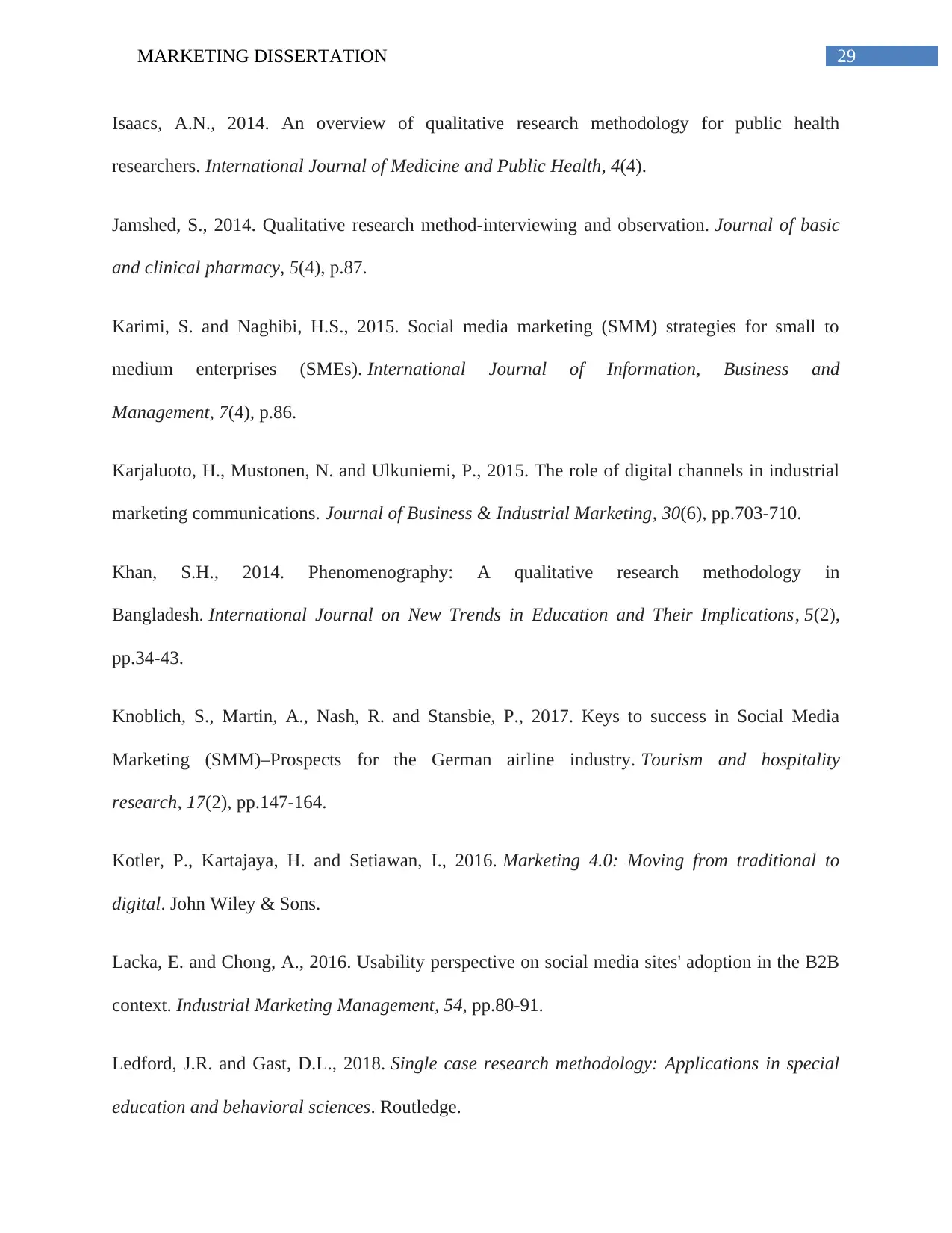
29MARKETING DISSERTATION
Isaacs, A.N., 2014. An overview of qualitative research methodology for public health
researchers. International Journal of Medicine and Public Health, 4(4).
Jamshed, S., 2014. Qualitative research method-interviewing and observation. Journal of basic
and clinical pharmacy, 5(4), p.87.
Karimi, S. and Naghibi, H.S., 2015. Social media marketing (SMM) strategies for small to
medium enterprises (SMEs). International Journal of Information, Business and
Management, 7(4), p.86.
Karjaluoto, H., Mustonen, N. and Ulkuniemi, P., 2015. The role of digital channels in industrial
marketing communications. Journal of Business & Industrial Marketing, 30(6), pp.703-710.
Khan, S.H., 2014. Phenomenography: A qualitative research methodology in
Bangladesh. International Journal on New Trends in Education and Their Implications, 5(2),
pp.34-43.
Knoblich, S., Martin, A., Nash, R. and Stansbie, P., 2017. Keys to success in Social Media
Marketing (SMM)–Prospects for the German airline industry. Tourism and hospitality
research, 17(2), pp.147-164.
Kotler, P., Kartajaya, H. and Setiawan, I., 2016. Marketing 4.0: Moving from traditional to
digital. John Wiley & Sons.
Lacka, E. and Chong, A., 2016. Usability perspective on social media sites' adoption in the B2B
context. Industrial Marketing Management, 54, pp.80-91.
Ledford, J.R. and Gast, D.L., 2018. Single case research methodology: Applications in special
education and behavioral sciences. Routledge.
Isaacs, A.N., 2014. An overview of qualitative research methodology for public health
researchers. International Journal of Medicine and Public Health, 4(4).
Jamshed, S., 2014. Qualitative research method-interviewing and observation. Journal of basic
and clinical pharmacy, 5(4), p.87.
Karimi, S. and Naghibi, H.S., 2015. Social media marketing (SMM) strategies for small to
medium enterprises (SMEs). International Journal of Information, Business and
Management, 7(4), p.86.
Karjaluoto, H., Mustonen, N. and Ulkuniemi, P., 2015. The role of digital channels in industrial
marketing communications. Journal of Business & Industrial Marketing, 30(6), pp.703-710.
Khan, S.H., 2014. Phenomenography: A qualitative research methodology in
Bangladesh. International Journal on New Trends in Education and Their Implications, 5(2),
pp.34-43.
Knoblich, S., Martin, A., Nash, R. and Stansbie, P., 2017. Keys to success in Social Media
Marketing (SMM)–Prospects for the German airline industry. Tourism and hospitality
research, 17(2), pp.147-164.
Kotler, P., Kartajaya, H. and Setiawan, I., 2016. Marketing 4.0: Moving from traditional to
digital. John Wiley & Sons.
Lacka, E. and Chong, A., 2016. Usability perspective on social media sites' adoption in the B2B
context. Industrial Marketing Management, 54, pp.80-91.
Ledford, J.R. and Gast, D.L., 2018. Single case research methodology: Applications in special
education and behavioral sciences. Routledge.
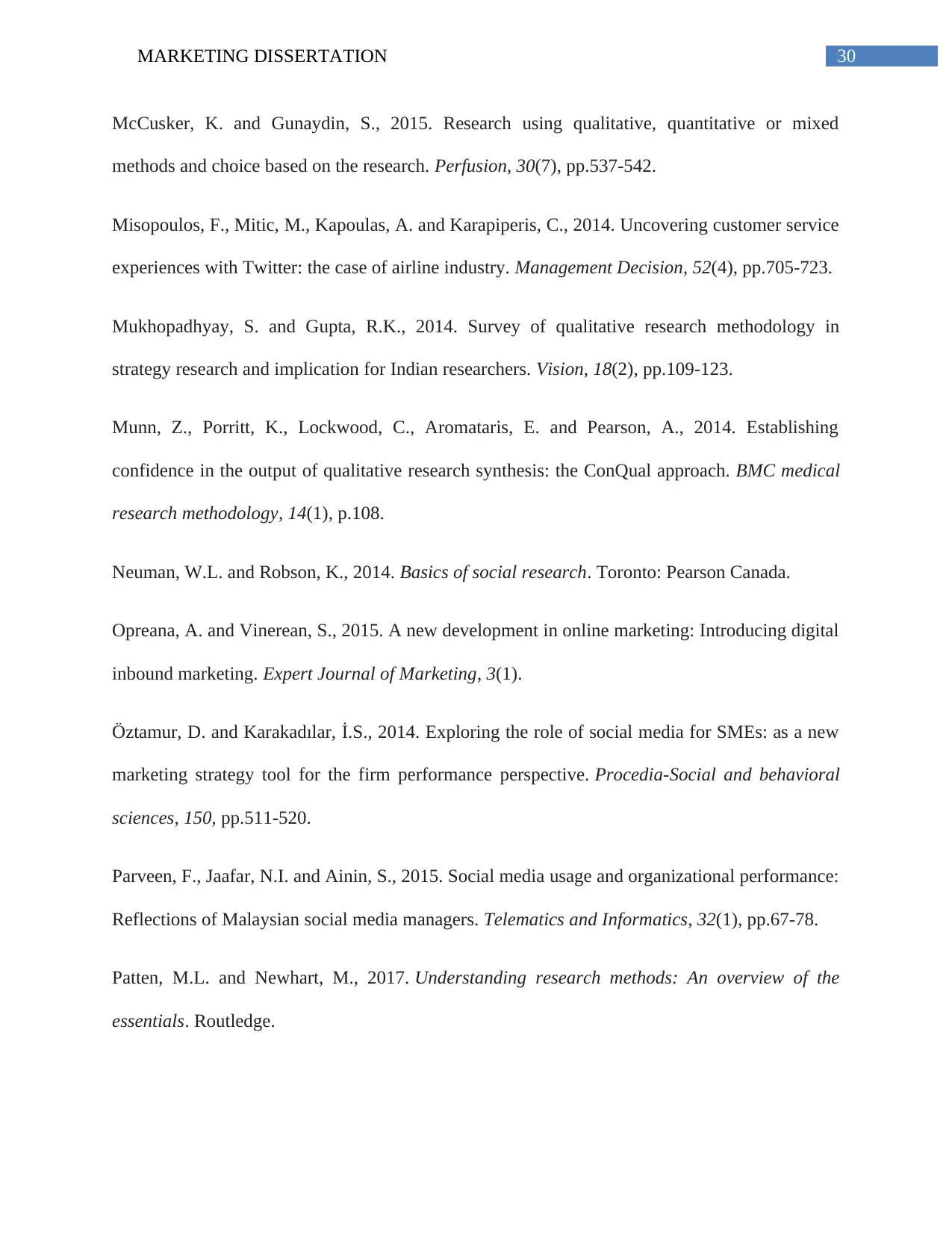
30MARKETING DISSERTATION
McCusker, K. and Gunaydin, S., 2015. Research using qualitative, quantitative or mixed
methods and choice based on the research. Perfusion, 30(7), pp.537-542.
Misopoulos, F., Mitic, M., Kapoulas, A. and Karapiperis, C., 2014. Uncovering customer service
experiences with Twitter: the case of airline industry. Management Decision, 52(4), pp.705-723.
Mukhopadhyay, S. and Gupta, R.K., 2014. Survey of qualitative research methodology in
strategy research and implication for Indian researchers. Vision, 18(2), pp.109-123.
Munn, Z., Porritt, K., Lockwood, C., Aromataris, E. and Pearson, A., 2014. Establishing
confidence in the output of qualitative research synthesis: the ConQual approach. BMC medical
research methodology, 14(1), p.108.
Neuman, W.L. and Robson, K., 2014. Basics of social research. Toronto: Pearson Canada.
Opreana, A. and Vinerean, S., 2015. A new development in online marketing: Introducing digital
inbound marketing. Expert Journal of Marketing, 3(1).
Öztamur, D. and Karakadılar, İ.S., 2014. Exploring the role of social media for SMEs: as a new
marketing strategy tool for the firm performance perspective. Procedia-Social and behavioral
sciences, 150, pp.511-520.
Parveen, F., Jaafar, N.I. and Ainin, S., 2015. Social media usage and organizational performance:
Reflections of Malaysian social media managers. Telematics and Informatics, 32(1), pp.67-78.
Patten, M.L. and Newhart, M., 2017. Understanding research methods: An overview of the
essentials. Routledge.
McCusker, K. and Gunaydin, S., 2015. Research using qualitative, quantitative or mixed
methods and choice based on the research. Perfusion, 30(7), pp.537-542.
Misopoulos, F., Mitic, M., Kapoulas, A. and Karapiperis, C., 2014. Uncovering customer service
experiences with Twitter: the case of airline industry. Management Decision, 52(4), pp.705-723.
Mukhopadhyay, S. and Gupta, R.K., 2014. Survey of qualitative research methodology in
strategy research and implication for Indian researchers. Vision, 18(2), pp.109-123.
Munn, Z., Porritt, K., Lockwood, C., Aromataris, E. and Pearson, A., 2014. Establishing
confidence in the output of qualitative research synthesis: the ConQual approach. BMC medical
research methodology, 14(1), p.108.
Neuman, W.L. and Robson, K., 2014. Basics of social research. Toronto: Pearson Canada.
Opreana, A. and Vinerean, S., 2015. A new development in online marketing: Introducing digital
inbound marketing. Expert Journal of Marketing, 3(1).
Öztamur, D. and Karakadılar, İ.S., 2014. Exploring the role of social media for SMEs: as a new
marketing strategy tool for the firm performance perspective. Procedia-Social and behavioral
sciences, 150, pp.511-520.
Parveen, F., Jaafar, N.I. and Ainin, S., 2015. Social media usage and organizational performance:
Reflections of Malaysian social media managers. Telematics and Informatics, 32(1), pp.67-78.
Patten, M.L. and Newhart, M., 2017. Understanding research methods: An overview of the
essentials. Routledge.
Paraphrase This Document
Need a fresh take? Get an instant paraphrase of this document with our AI Paraphraser
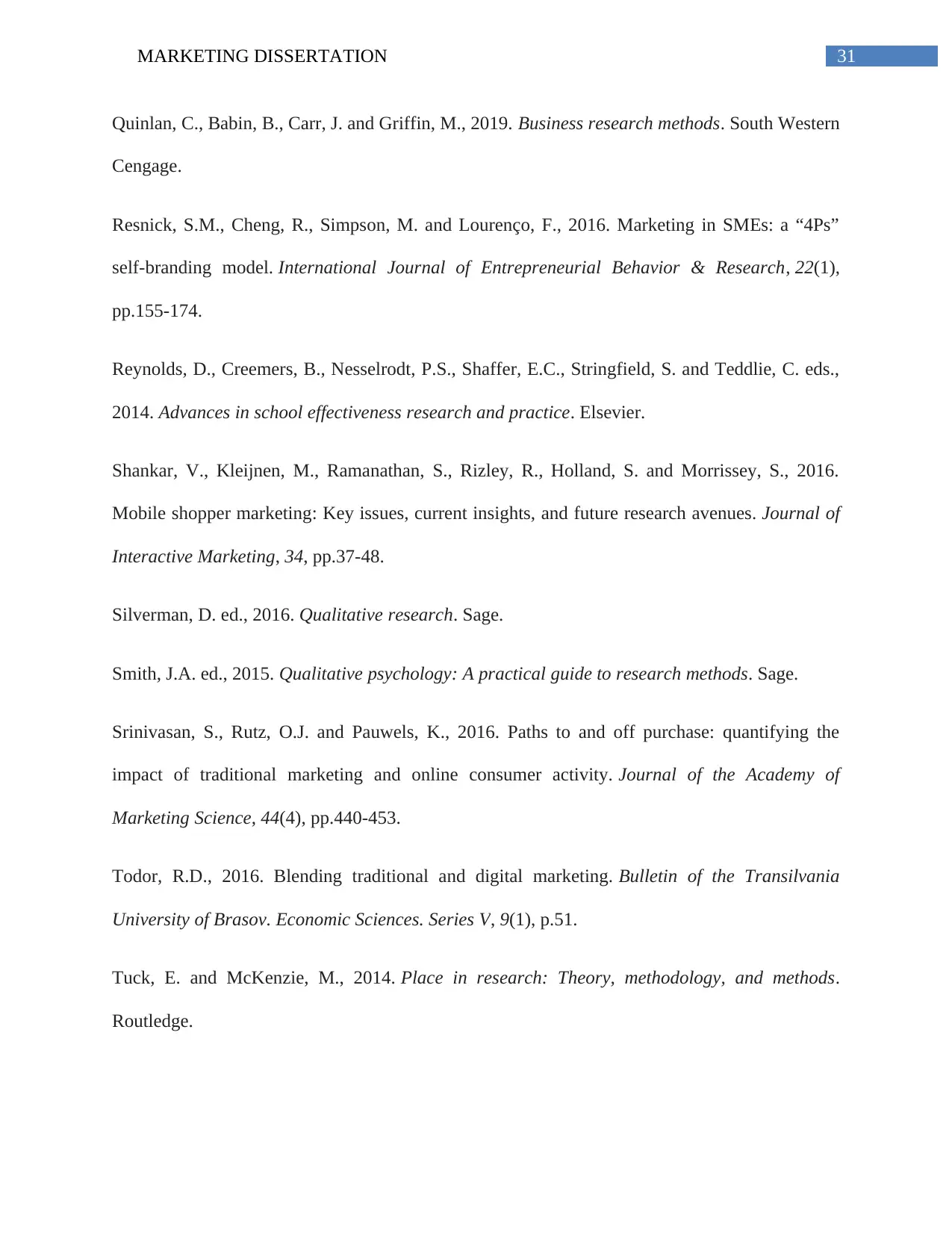
31MARKETING DISSERTATION
Quinlan, C., Babin, B., Carr, J. and Griffin, M., 2019. Business research methods. South Western
Cengage.
Resnick, S.M., Cheng, R., Simpson, M. and Lourenço, F., 2016. Marketing in SMEs: a “4Ps”
self-branding model. International Journal of Entrepreneurial Behavior & Research, 22(1),
pp.155-174.
Reynolds, D., Creemers, B., Nesselrodt, P.S., Shaffer, E.C., Stringfield, S. and Teddlie, C. eds.,
2014. Advances in school effectiveness research and practice. Elsevier.
Shankar, V., Kleijnen, M., Ramanathan, S., Rizley, R., Holland, S. and Morrissey, S., 2016.
Mobile shopper marketing: Key issues, current insights, and future research avenues. Journal of
Interactive Marketing, 34, pp.37-48.
Silverman, D. ed., 2016. Qualitative research. Sage.
Smith, J.A. ed., 2015. Qualitative psychology: A practical guide to research methods. Sage.
Srinivasan, S., Rutz, O.J. and Pauwels, K., 2016. Paths to and off purchase: quantifying the
impact of traditional marketing and online consumer activity. Journal of the Academy of
Marketing Science, 44(4), pp.440-453.
Todor, R.D., 2016. Blending traditional and digital marketing. Bulletin of the Transilvania
University of Brasov. Economic Sciences. Series V, 9(1), p.51.
Tuck, E. and McKenzie, M., 2014. Place in research: Theory, methodology, and methods.
Routledge.
Quinlan, C., Babin, B., Carr, J. and Griffin, M., 2019. Business research methods. South Western
Cengage.
Resnick, S.M., Cheng, R., Simpson, M. and Lourenço, F., 2016. Marketing in SMEs: a “4Ps”
self-branding model. International Journal of Entrepreneurial Behavior & Research, 22(1),
pp.155-174.
Reynolds, D., Creemers, B., Nesselrodt, P.S., Shaffer, E.C., Stringfield, S. and Teddlie, C. eds.,
2014. Advances in school effectiveness research and practice. Elsevier.
Shankar, V., Kleijnen, M., Ramanathan, S., Rizley, R., Holland, S. and Morrissey, S., 2016.
Mobile shopper marketing: Key issues, current insights, and future research avenues. Journal of
Interactive Marketing, 34, pp.37-48.
Silverman, D. ed., 2016. Qualitative research. Sage.
Smith, J.A. ed., 2015. Qualitative psychology: A practical guide to research methods. Sage.
Srinivasan, S., Rutz, O.J. and Pauwels, K., 2016. Paths to and off purchase: quantifying the
impact of traditional marketing and online consumer activity. Journal of the Academy of
Marketing Science, 44(4), pp.440-453.
Todor, R.D., 2016. Blending traditional and digital marketing. Bulletin of the Transilvania
University of Brasov. Economic Sciences. Series V, 9(1), p.51.
Tuck, E. and McKenzie, M., 2014. Place in research: Theory, methodology, and methods.
Routledge.
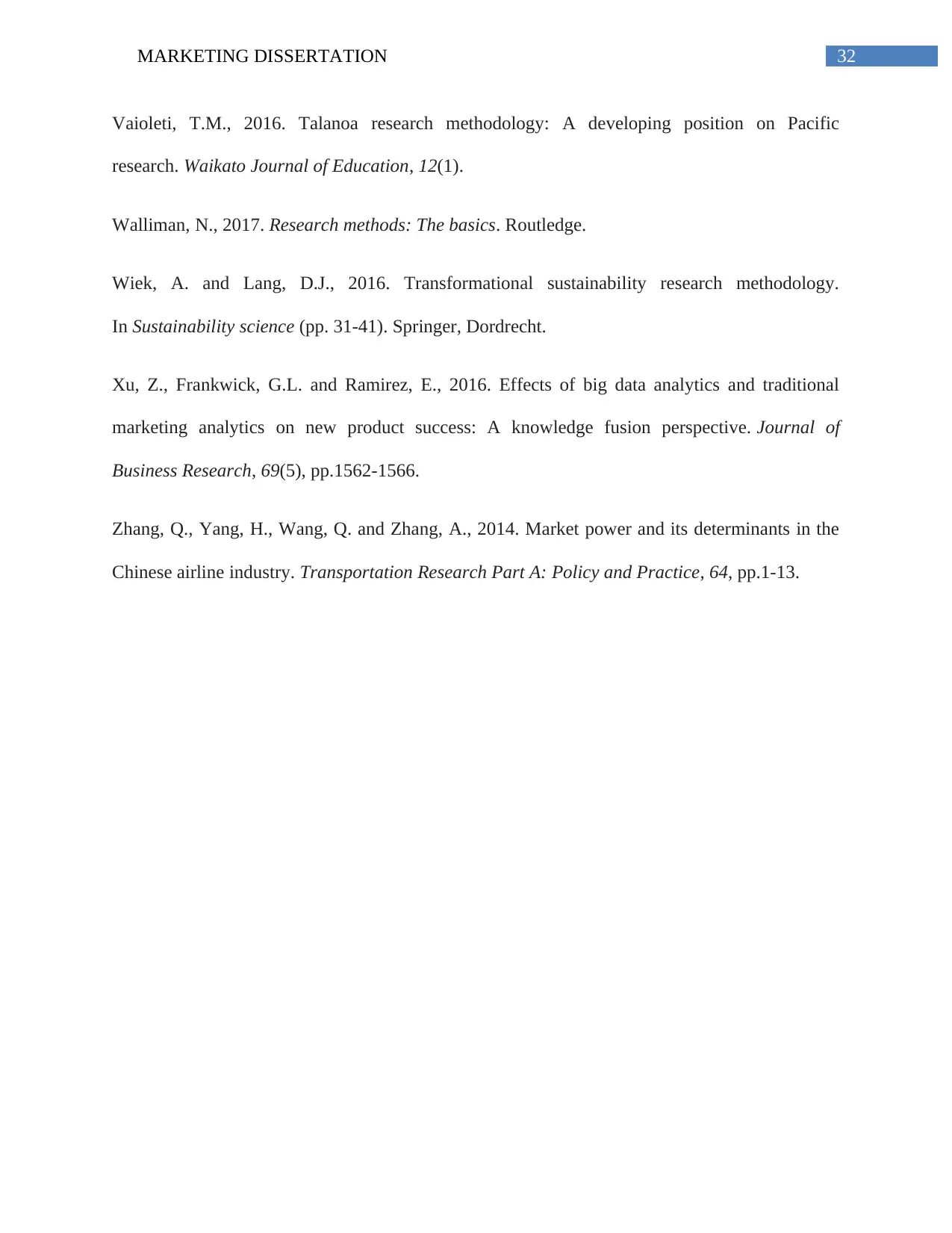
32MARKETING DISSERTATION
Vaioleti, T.M., 2016. Talanoa research methodology: A developing position on Pacific
research. Waikato Journal of Education, 12(1).
Walliman, N., 2017. Research methods: The basics. Routledge.
Wiek, A. and Lang, D.J., 2016. Transformational sustainability research methodology.
In Sustainability science (pp. 31-41). Springer, Dordrecht.
Xu, Z., Frankwick, G.L. and Ramirez, E., 2016. Effects of big data analytics and traditional
marketing analytics on new product success: A knowledge fusion perspective. Journal of
Business Research, 69(5), pp.1562-1566.
Zhang, Q., Yang, H., Wang, Q. and Zhang, A., 2014. Market power and its determinants in the
Chinese airline industry. Transportation Research Part A: Policy and Practice, 64, pp.1-13.
Vaioleti, T.M., 2016. Talanoa research methodology: A developing position on Pacific
research. Waikato Journal of Education, 12(1).
Walliman, N., 2017. Research methods: The basics. Routledge.
Wiek, A. and Lang, D.J., 2016. Transformational sustainability research methodology.
In Sustainability science (pp. 31-41). Springer, Dordrecht.
Xu, Z., Frankwick, G.L. and Ramirez, E., 2016. Effects of big data analytics and traditional
marketing analytics on new product success: A knowledge fusion perspective. Journal of
Business Research, 69(5), pp.1562-1566.
Zhang, Q., Yang, H., Wang, Q. and Zhang, A., 2014. Market power and its determinants in the
Chinese airline industry. Transportation Research Part A: Policy and Practice, 64, pp.1-13.
1 out of 33
Related Documents
Your All-in-One AI-Powered Toolkit for Academic Success.
+13062052269
info@desklib.com
Available 24*7 on WhatsApp / Email
![[object Object]](/_next/static/media/star-bottom.7253800d.svg)
Unlock your academic potential
© 2024 | Zucol Services PVT LTD | All rights reserved.





